Allison Collection Photos
March- September, 1945
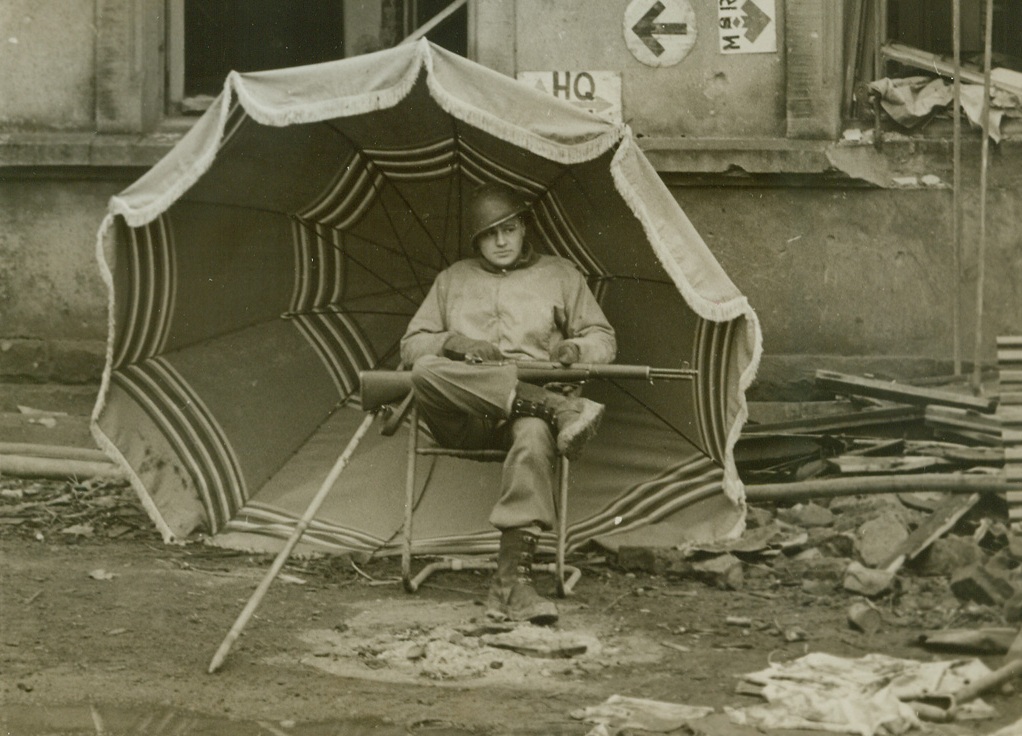
All the Comforts. . ., 3/6/1945. Grundhof, Luxembourg—Stationed in front of the railroad terminal at Grundhof, this ingenius Yank MP isn’t bothered by the rain. Snug as a bug, he’s sheltered by a large beach umbrella, found in a vacant house nearby. Photo by Charles Haacker, ACME photographer for the War Picture Pool. Credit: ACME.;

De-armed Army, 3/30/1945. Germany—Droves of German prisoners, captured as the American forces advanced across the Rhine at Remagen, are packed into this area to await transfer to prison camps. Note some in civilian clothes. They deserted from the German army and hid in cellars and other hide-outs until American forces reached them. Prisoners, which daily number in the thousands, are rapidly swelling the Allied prison camps to capacity. Credit: ACME.;
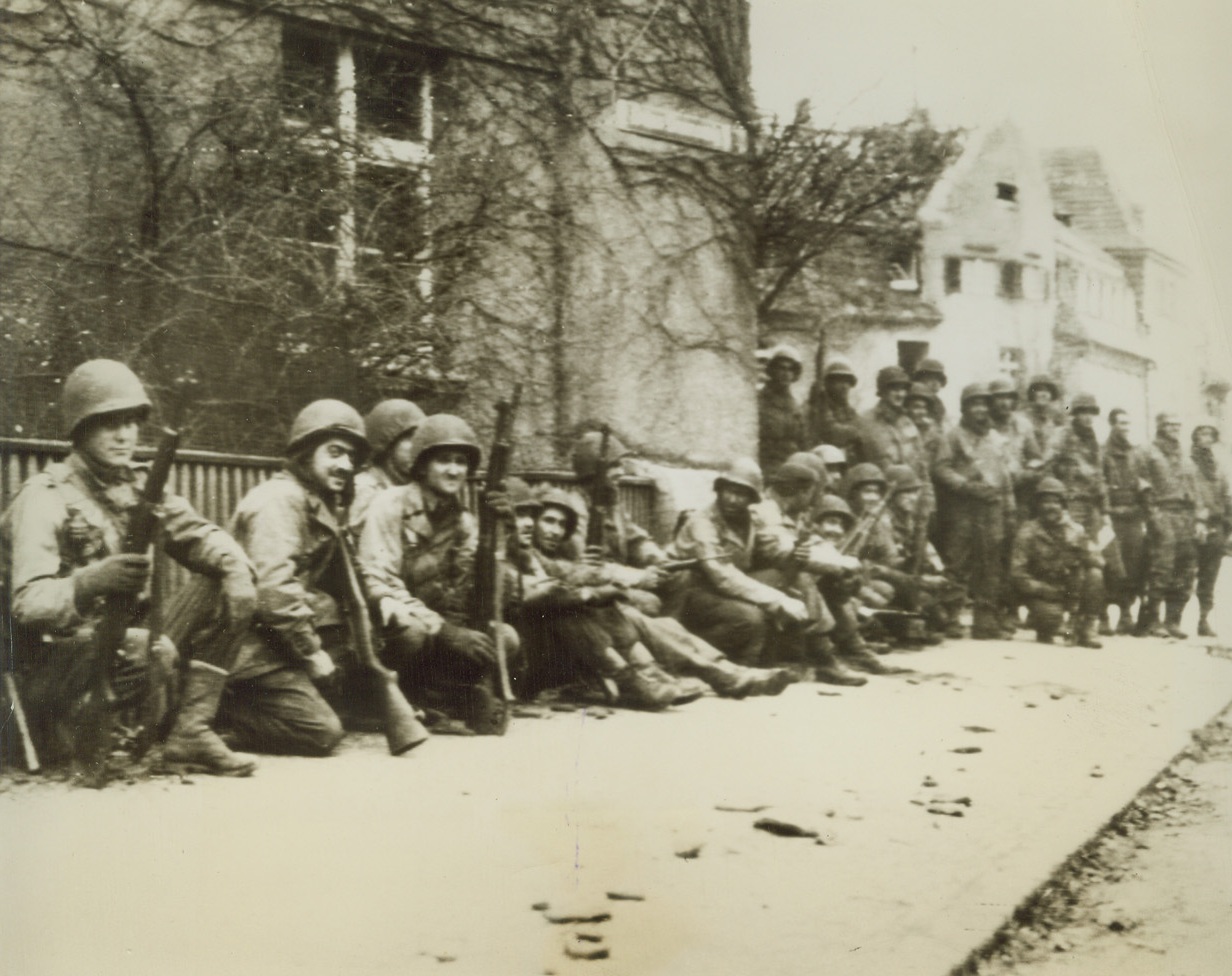
YANKS CAPTURE COLOGNE, 3/6/1943. GERMANY—Troops of the U.S. 1st Army, get a well-earned rest in a back street in Cologne, after forcing their way into the Rhineland capital. Announcement late tonight, said they had captured the city.Credit: Acme photo via Army Radiotelephoto;

In Ninth Army’s Path, 3/5/1943. Here is an airview of much-bombed Essen, showing Germany’s vital Krupp works, railroad center and utilities. The great Ruhr industrial city lies in the path of the U.S. Ninth Army, now that Yanks of that fighting force have driven across the Rhine.Credit: (ACME);
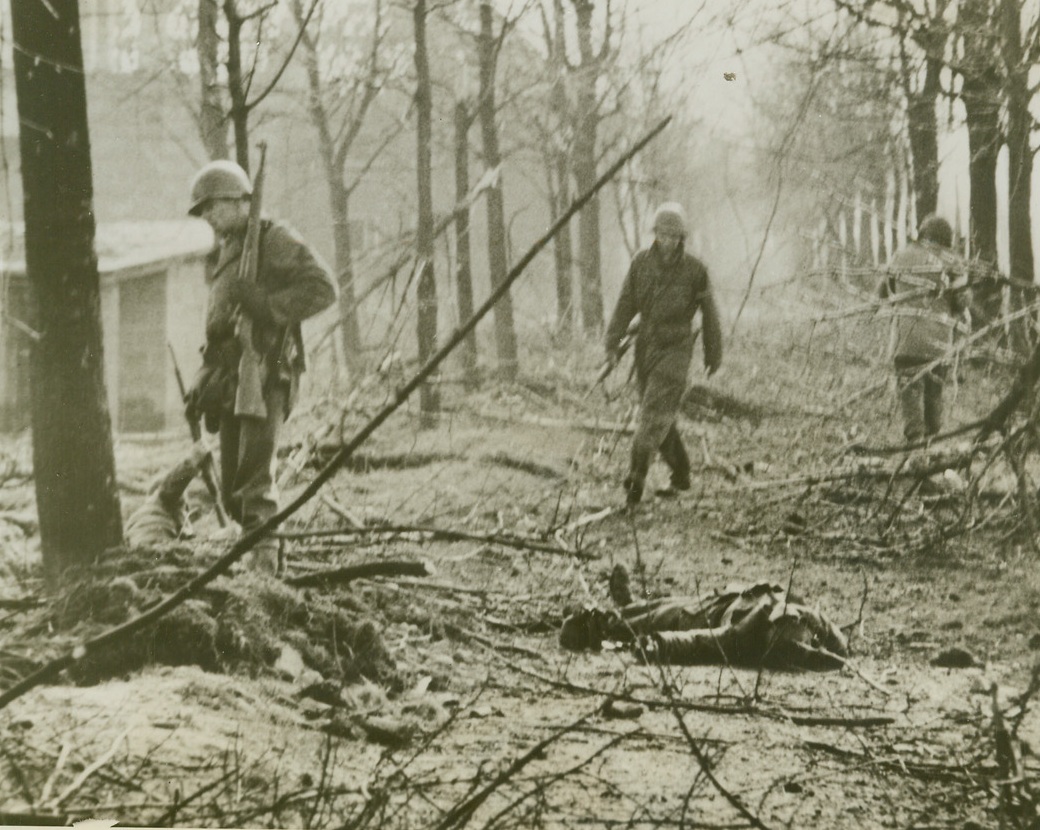
They Cornered Him – So He Bit, 3/3/1945. ROER RIVER, GERMANY – These three American soldiers stagger around dazed from the repercussions of a hand grenade which a German prisoner, captured during the Roer River crossing, lies dead in the foreground. A badly wounded GI behind the three at left is leaning on his rifle in an effort to get to his feet. The fellow standing makes no effort ot help him because he, too, is badly wounded (not peculiar way he holds his rifle.)Credit (ACME) (WP);

Canadians Move Up On Calcar, 3/3/1945. Germany – Canadian troops and armour move forward across the German plain in a widening arc advancing on Calcar, key city west of the Rhine. After capturing Calcar, the Canadians pushed southward, and are now reported to be within 10 miles of a junction with the US 8th Army. 3/3/45 Credit (ACME) (WP);

Slaves No More, 3/30/1945. Germany— Civilians, who were imported by the Germans from occupied countries to serve as slave laborers, crowd into the displaced persons center to receive their food rations after their liberation by advancing Allied Armies. In this group are people of all nationalities— Poles, French, Belgians, and Russians, and eventually Allied military authorities will see that they are sent back to their homelands. 3/30/45 Acme;

Flight from Cologne, 3/6/1945. GERMANY -- As U.S. First Army troops drove toward Cologne along a road marked by death and devastation, streams of civilians, fleeing the besieged city, trudged toward them. All walking, some pushing bicycles, others trundling carts laden with personal possessions, the Germans found the going as rough as it often was for victims of the once-victorious Nazis. Photo by Harold Siegman, Acme photographer for the War Picture Pool. Credit: - WP- (ACME);
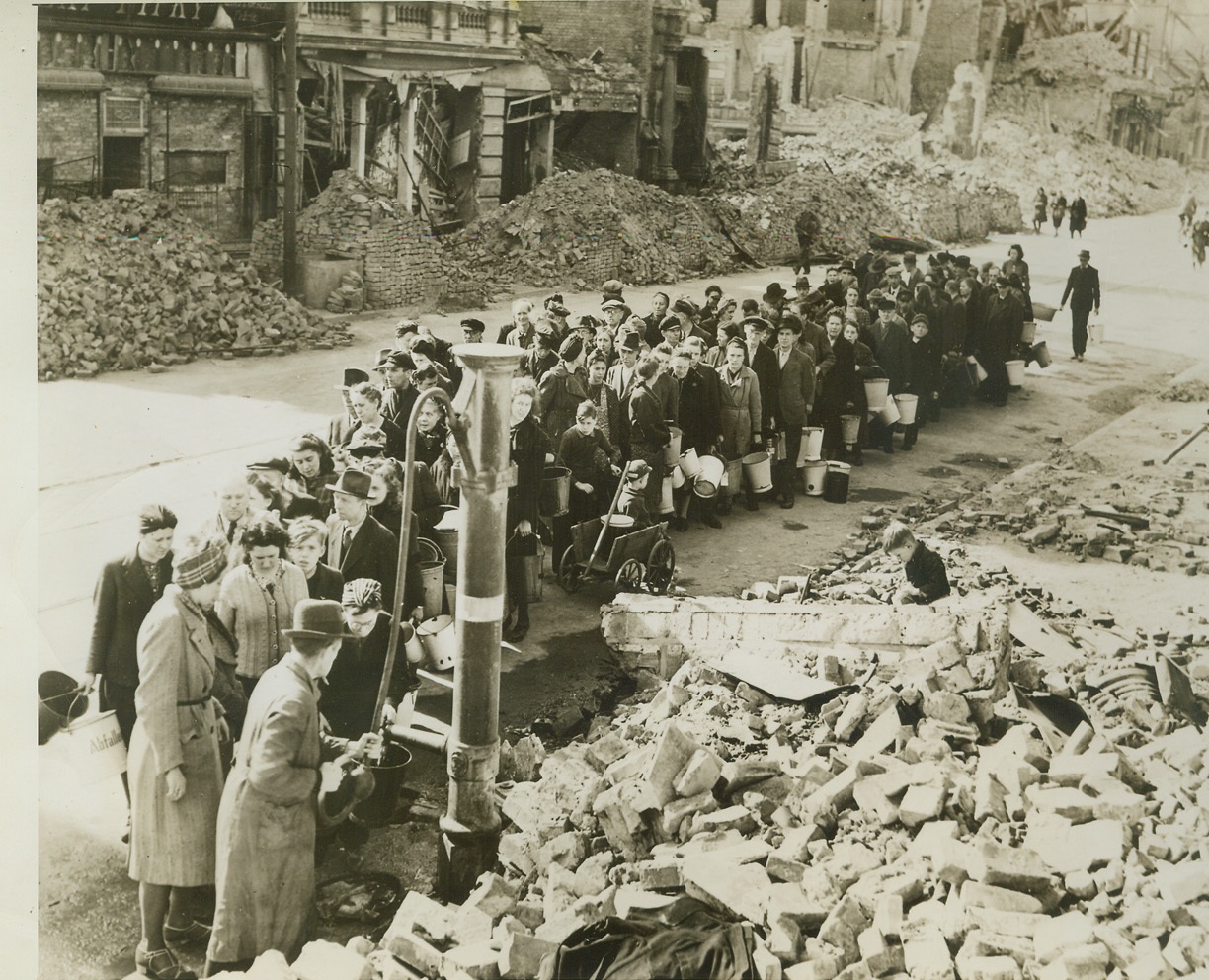
Rush Growler for Water, 4/29/1945. Germany—German civilians line up for supply water from one of few sources in Magdeburg after capture by Allies. Water from the pump is handed out in small rations. Credit –WP- (ACME);
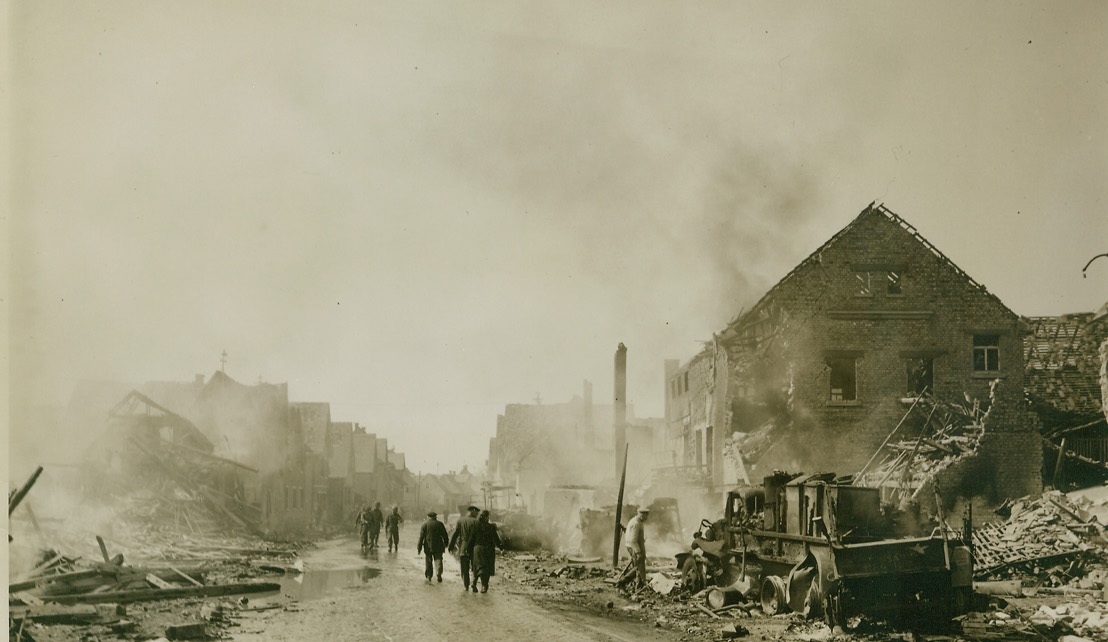
Fire – Everywhere, Fire, 4/2/1945. LESHEIM, GERMANY – It will take a lot of reconstruction to restore this main street in Lesheim to its former prominence. In the midst of the building wreckage, U.S. Army vehicles burn after they were hit by German guns outside the town. Much of the damage was caused when 4.2 shells, stored in the vehicles, were hit by German shells and exploded. Photo by Charles Haacker, Acme War Pool Photographer.;
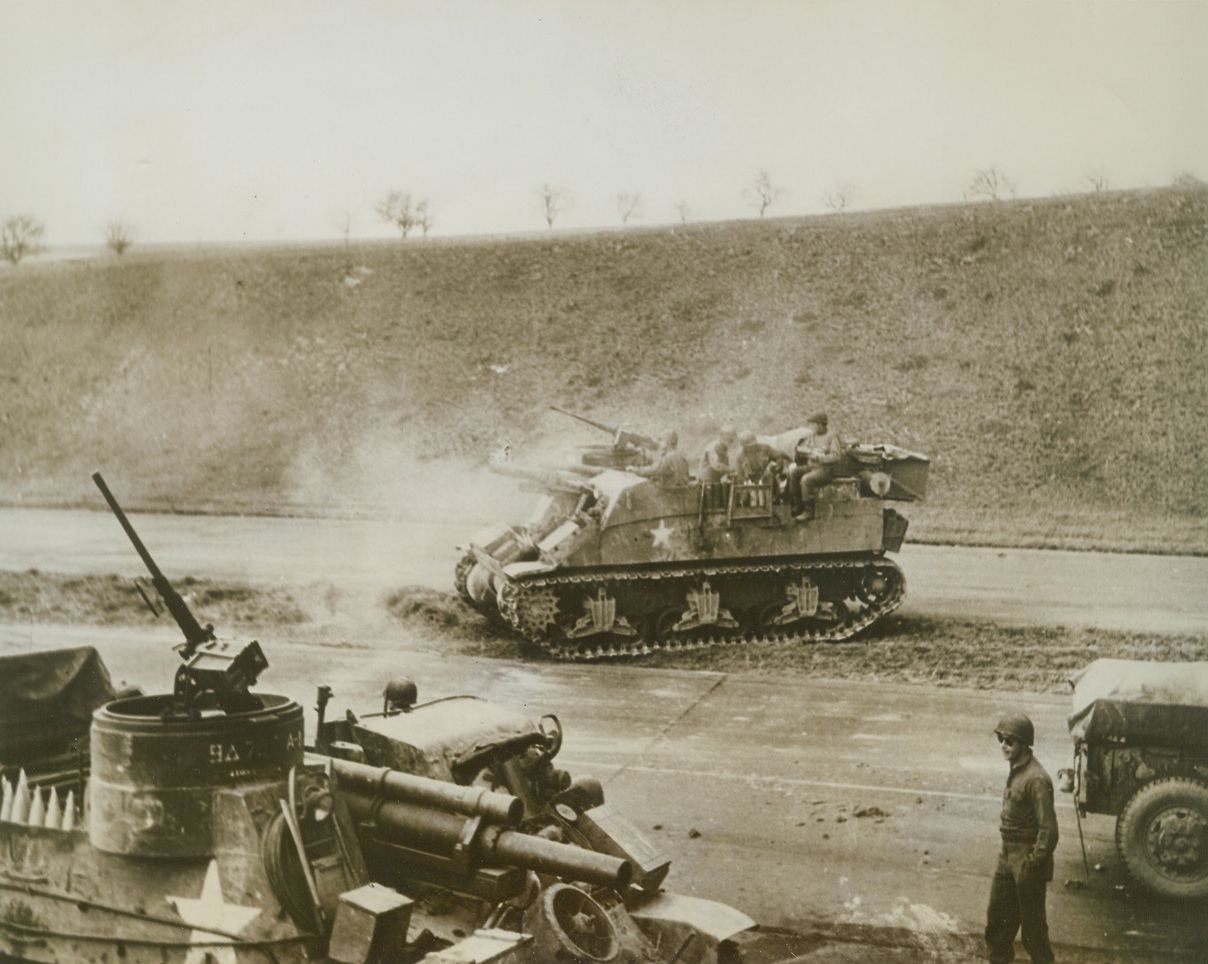
BLASTING THE ENEMY, 4/6/1945. GERMANY—Astride one of Hitler’s military super highways, self-propelled 105mm guns blast away at Nazi anti-tankers near Werschau. Troopers are part of 9th Armored Division, U.S. First Army.Credit: Acme;
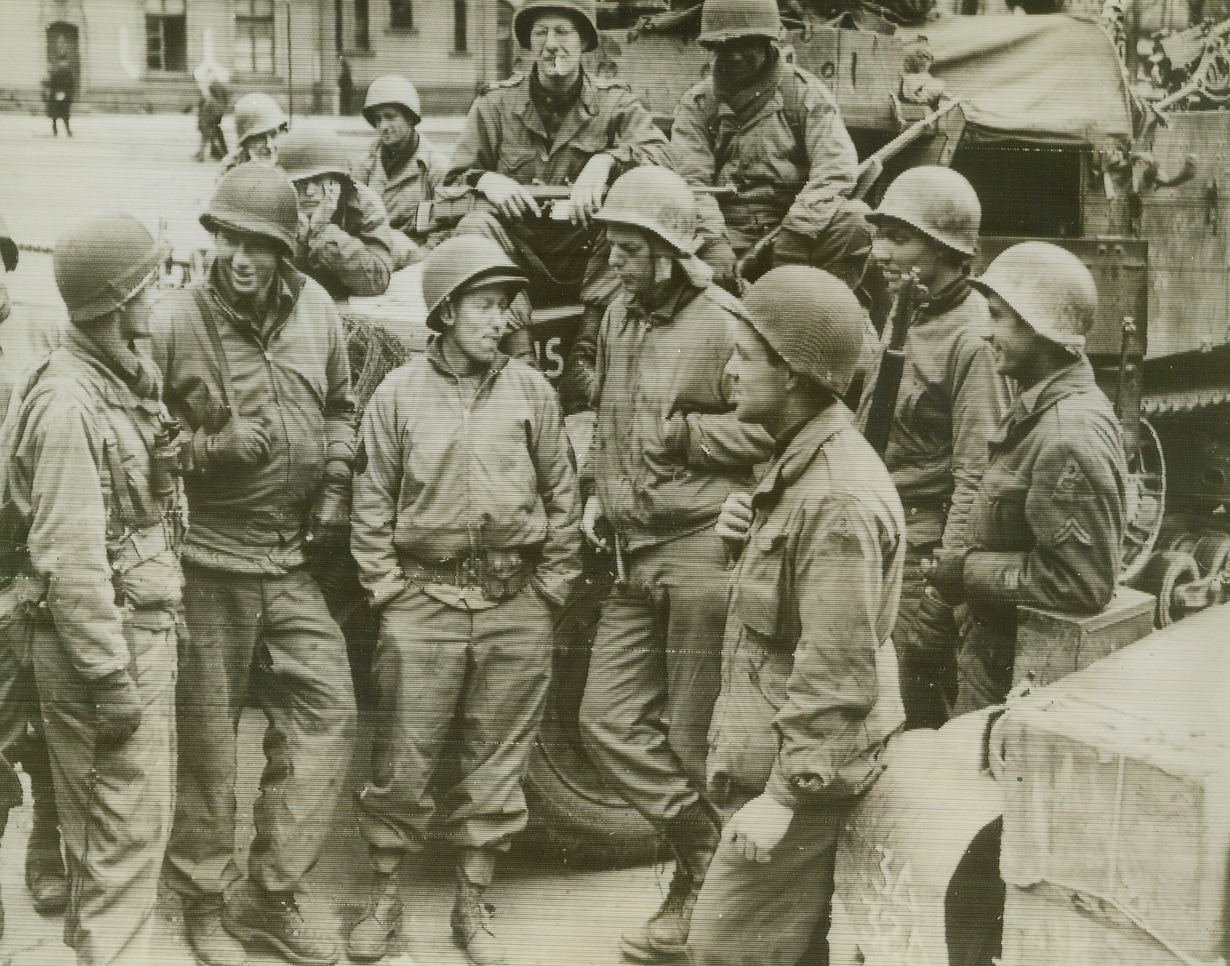
Yanks Join to Cut Ruhr, 4/2/1945. Germany—At Lippstadt, Germany, men of the 2nd Armored Division, U.S. Ninth Army, join forces with the troops of the 3rd Armored Division, U.S. First Army, to complete encirclement of the Ruhr and isolate the industrial heart of Germany. Credit: Radiophoto from ACME.;

On the Road to Munster, 4/3/1945. GERMANY—British troops and transports go streaming towards Munster through the ruined, rubble-strewn German town of Stadtlohn. Credit: OFFICIAL BRITISH RADIOPHOTO-ACME.;

GI’S RECAPTURED BY OWN MEN, 4/6/1945. Captured by the Nazis in the Bulge, these Yanks, part of a group of 100, wave to members of the 9th Armored Division, U.S. First Army, after being liberated in Montabourg. Credit: Acme;
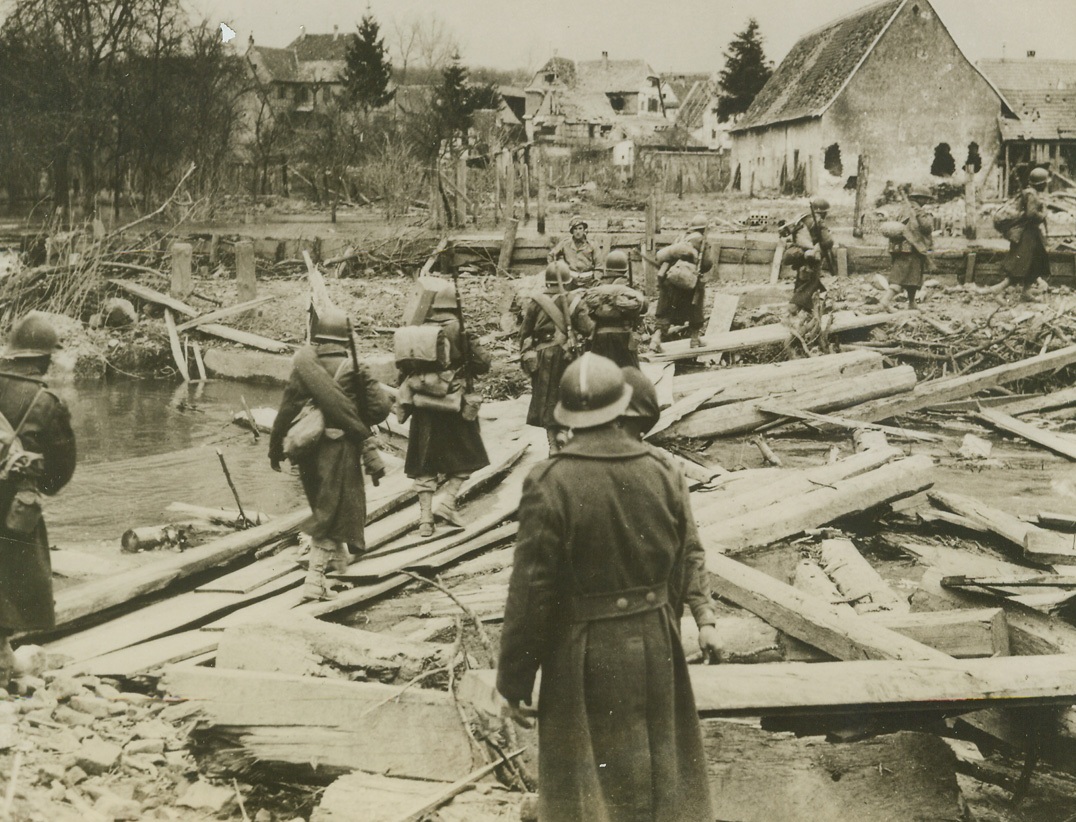
Tunisian Troops in Germany, 4/2/1945. GERMANY – Tunisian troops of the French Army cross improvised wooden bridge spanning the Lauter River to enter Germany. Crossing was made into city of Schriebenhardt. This was first time members of the French Army had entered the Fatherland.Credit – WP – (ACME);
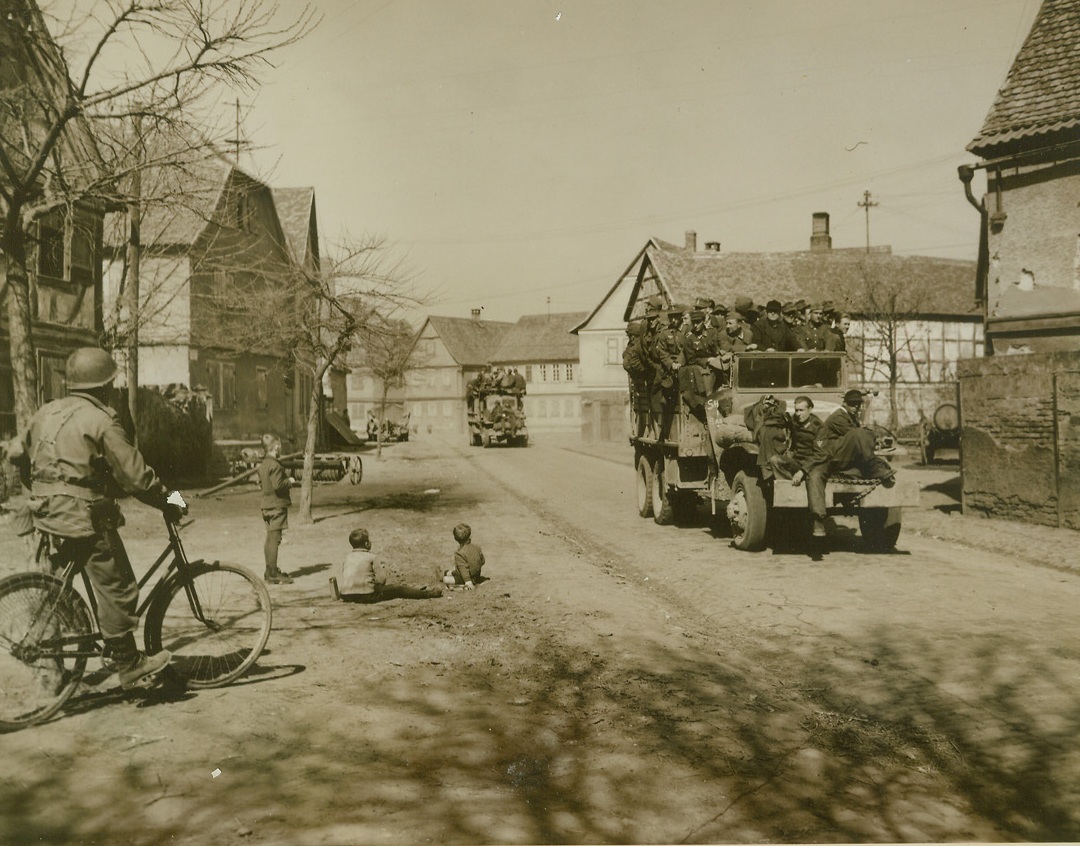
Wayside Onlookers, 4/2/1945. TREBUR, GERMANY – Two small German children look up from their game as truckloads of German prisoners, captured as the Third Army expanded its bridgehead east of the Rhine, moved through a desolate street in Trebur, Germany. Overflow of prisoners ride on the front bumpers. Photo by Charles Haacker, Acme war pool photographer.Credit (ACME) (WP);

EMACIATED AMERICANS, 4/7/1945. LIMBURG AREA, GERMANY—Half-starved and badly cared for while they were held prisoners of the Germans at a camp near Limburg, these American soldiers now rest comfortably and receive good care from U.S. First Army medical men, members of the forces which captured the camp. Left to right: Pfc. Ray Hayes, Pores Knob, N.C.; Pfc. Castos Solomon, San Antonio, Tex.; Pvt. James Gore, Albany, N.Y.; and Pfc. Joseph Noughton, Luzerne, Pa. The medic is T/5 Jerome Sloven (right), Bronx, N.Y. The bed-ridden men were taken prisoners at Vetz. Credit: Acme;
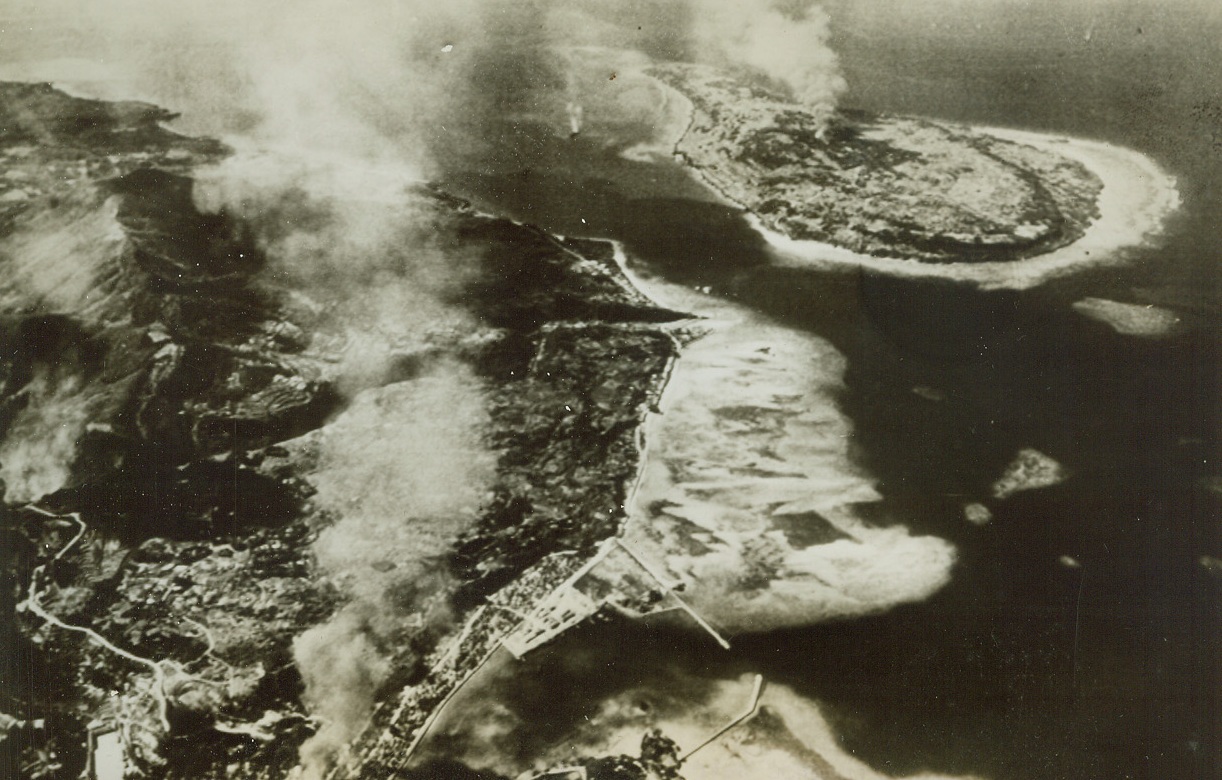
Wash-461, 4/1/1945. Columns of smoke mark bomb hits on Toguchi Town of Okinawa and a neighboring islet during a Navy carrier strike in the Ryukyus. Marines have landed on Okinawa Island, less than 400 miles from Jap mainland. Credit: Navy Photo from Acme (See Press Wires);
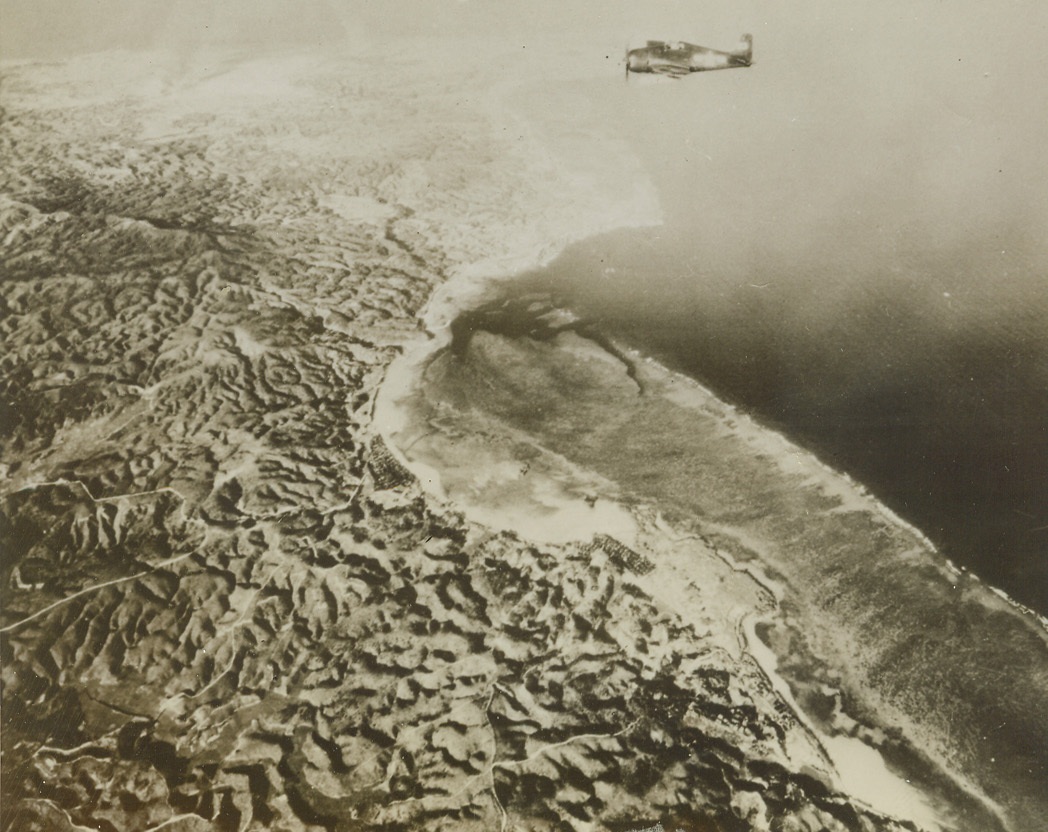
They Chewed It – Now They’ll Swallow It, 4/1/1945. Okinawa, Ryukyu Is. – For many months the target for bombs dropped by Navy Carrier-based planes, Okinawa, largest of the Ryukyu Islands, was invaded on the morning of April 1 by the U.S. 10th Army and the Third Marine Amphibious Corps, with the assistance of the U.S. Fifth Fleet and British ships. Here a Navy Grumman Hellcat soars over the jagged terrain of the island, which is only 325 miles from Japan. Landings were made on the Keramas, south of Okinawa, on March 26.Credit: Official U.S. Navy photo from ACME;
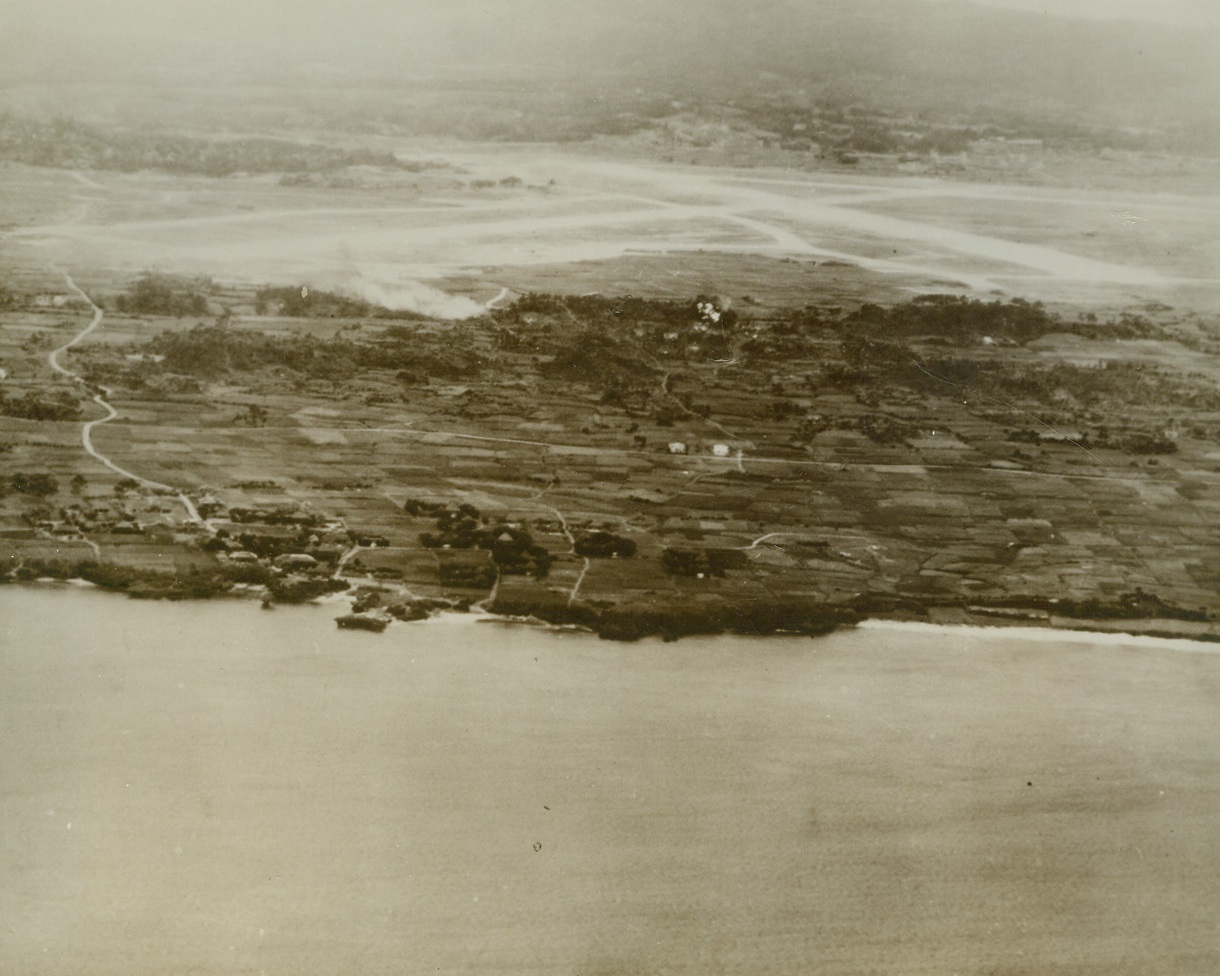
Taken by Yanks on Okinawa, 4/1/1945. Okinawa – Thirteen miles north of Naha, capital of Okinawa in the Ryukyu chain, is the Yontan Airdrome, taken by Marines and Infantrymen of the newly formed 10th Army after invasion of the island April 1st. Only a mile from the coast, it is on high ground with good drainage. The longest of its three coral strips runs from left to right in photo and is 5,100 feet in length. Marines took the airdrome only one hour after invasion.Credit: U.S. Navy photo from ACME;
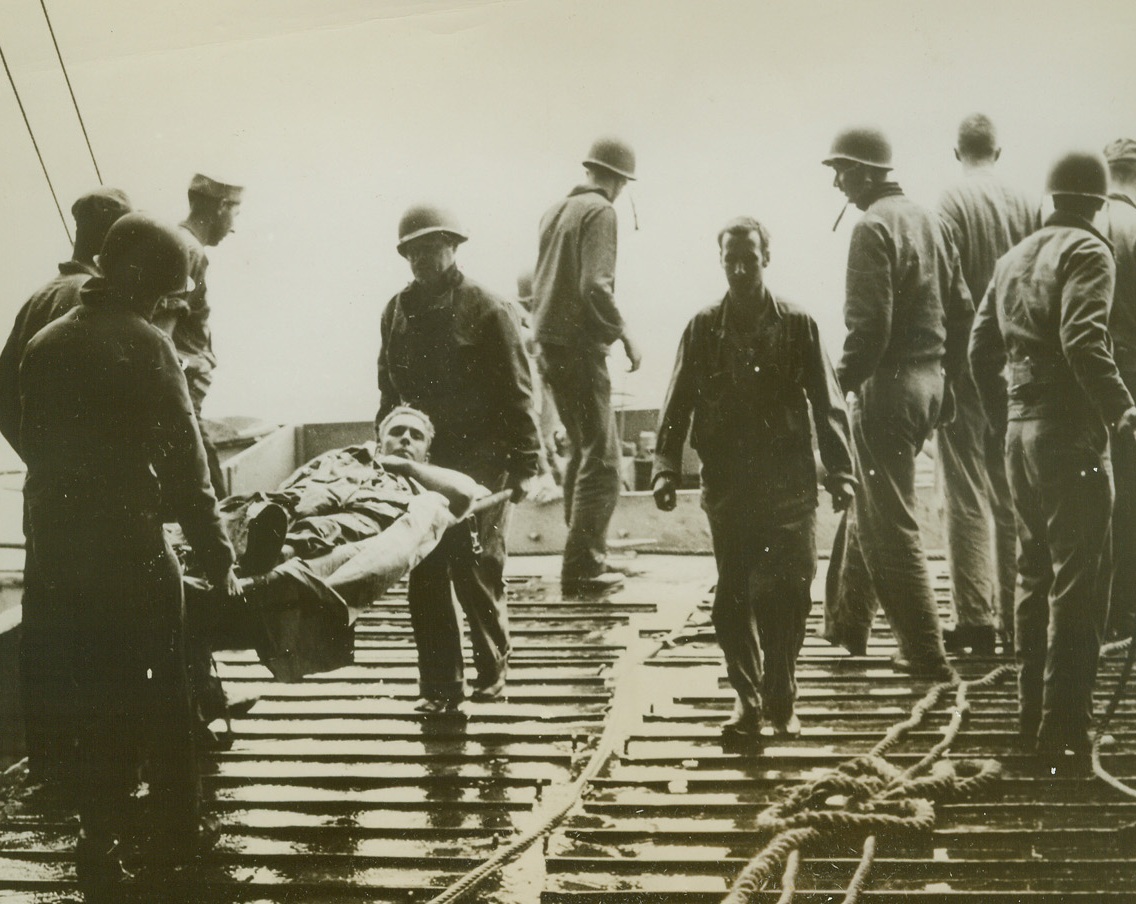
First Casualty of Ryukyus Assault, 4/7/1945. Pacific -- An American soldier of the 10th Army’s 77th division is carried by Coast Guardsmen through the big bow doors into the tank deck of an LST taking part in assault on Islands in the Ryukyus. Soldier was first reported casualty of invasion of the island chain just below Japan. He was wounded by a Jap sniper on beach of Aka Shima in the Keramas.Credit Line (Coast Guard photo from ACME;
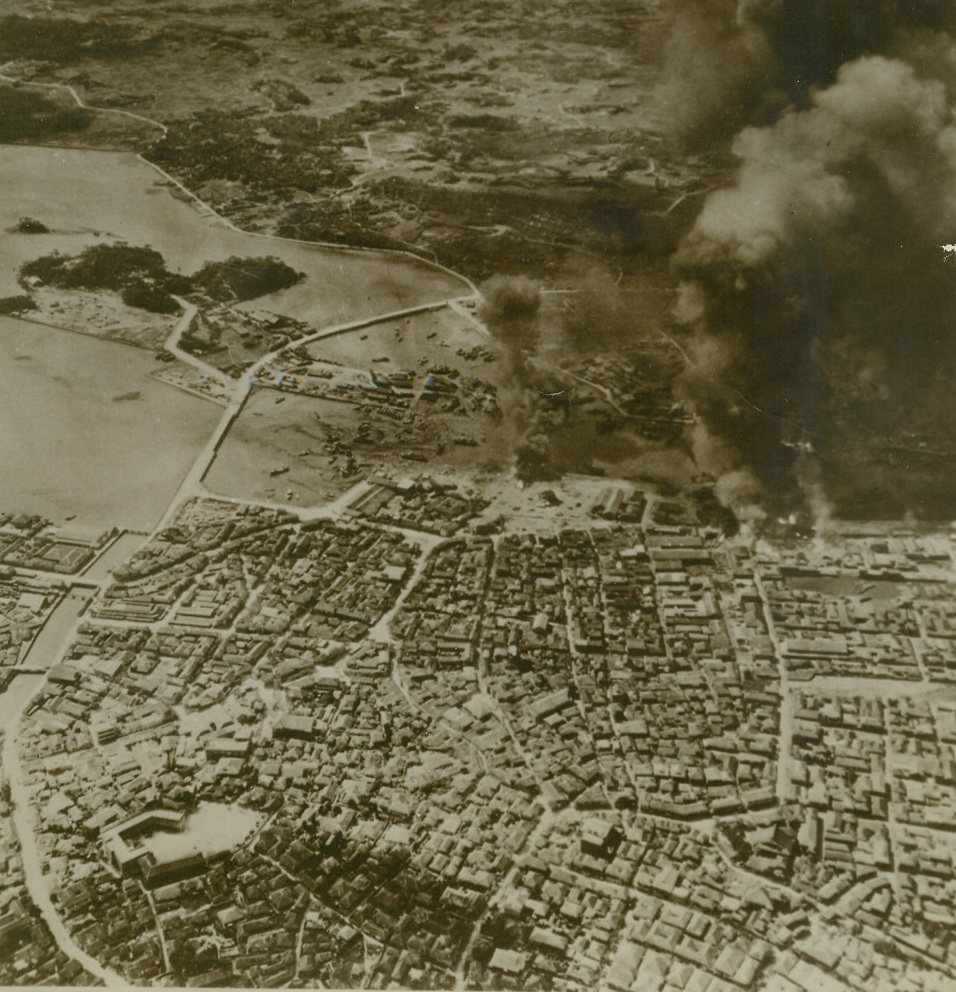
Marines On Okinawa Head for Naha, 4/1/1945. Okinawa – Infantrymen and Marines of the newly formed 10th Army were reported only eight miles from Naha, capital of Okinawa in the Ryukyu chain, after invasion of the island on April 1st. Smoke towers into the sky from the dock area of the city after pre-invasion strike by Navy bombers. Credit (U.S. Navy photo from ACME);
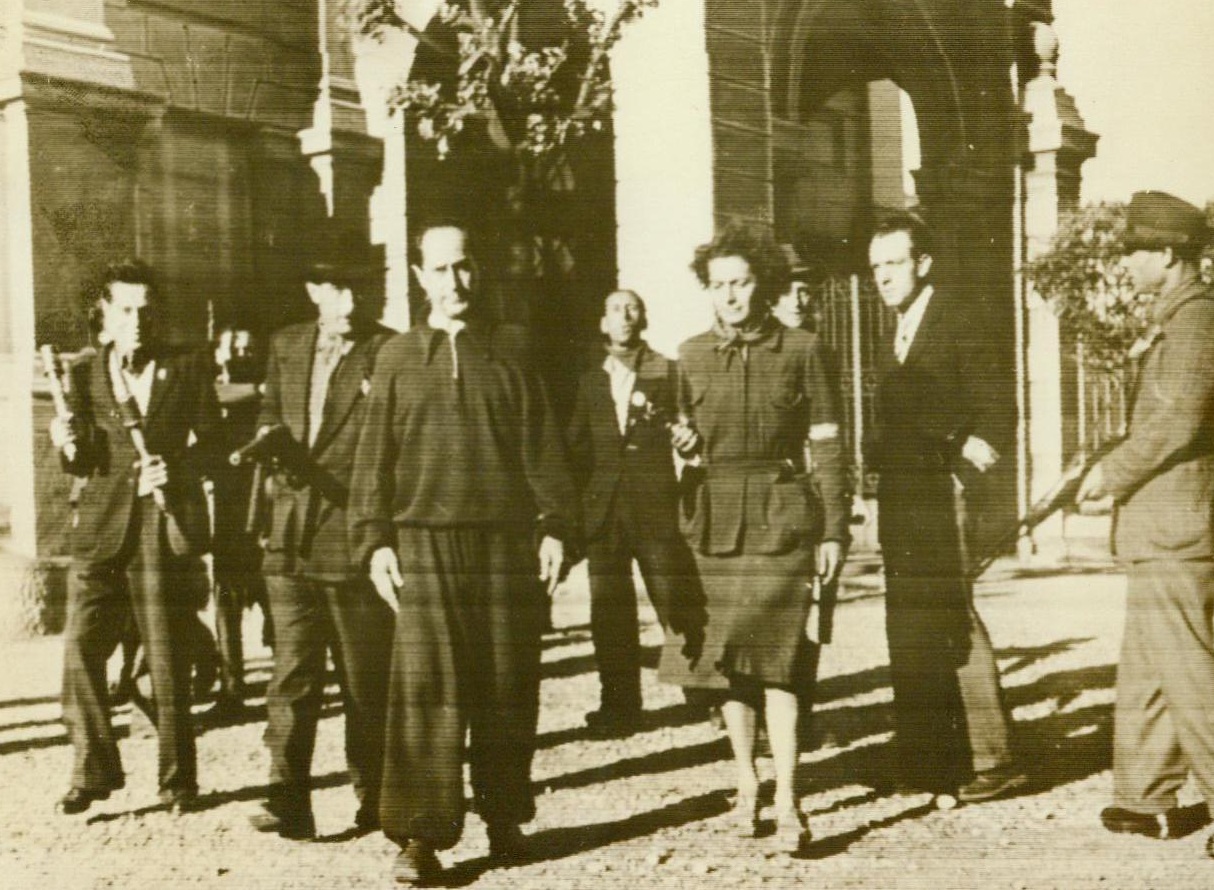
Led To Execution, 4/30/1945. Italy— Lt. Gen. Achille Starace, Secretary-General of the Fascist Party, is being led to his execution by partisans in Milan after being shown the bodies of Benito Mussolini and Clara Pettaci. Starace was shot in... Illegible;

Destroyers Help Rebuild, 4/10/1945. Manila—Japanese prisoners of war, identified by the letters “PW” on their backs, march down Rizal avenue on the way to their daily work of clearing up the wreckage of sections of Manila they, and their Nip comrades wantonly destroyed as the Yanks were taking the …. U.S. military police guard the group. Credit line (ACME);
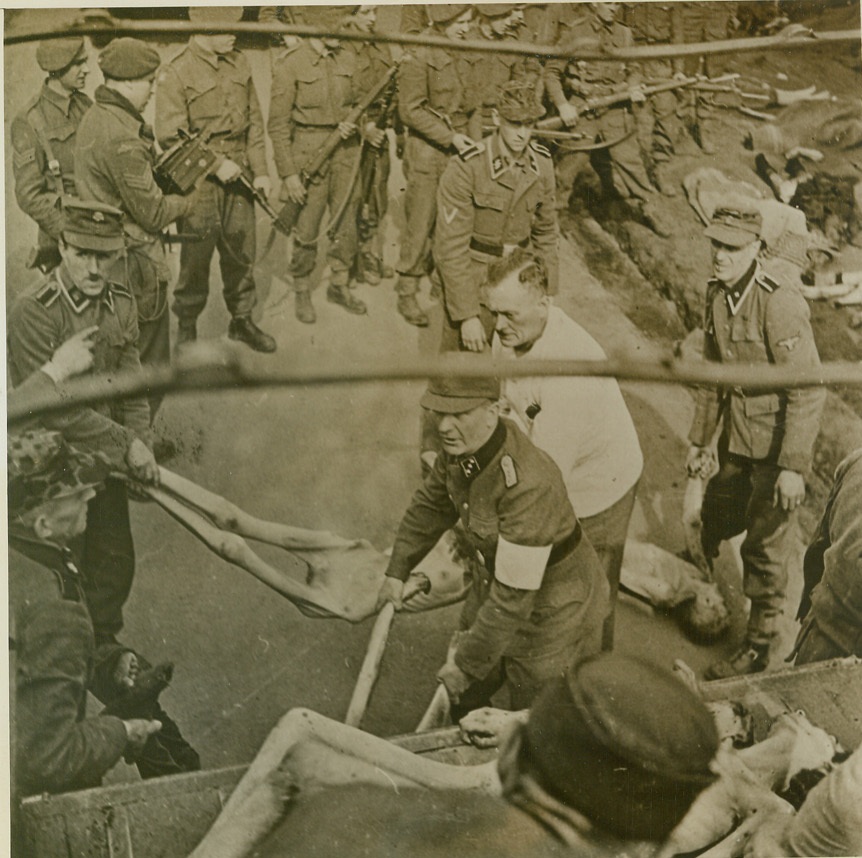
Remove the Dead for Burial, 4/27/1945. GERMANY – SS troops who had been posted at Nazi concentration camp at Belsen, Germany, load trucks with the bodies of their victims for transportation to burial grounds. British Second Army soldiers, who liberated the camp, look on with disgust and horror as Nazis lift emaciated bodies of the dead onto trucks. Credit (British Official Photo from ACME);
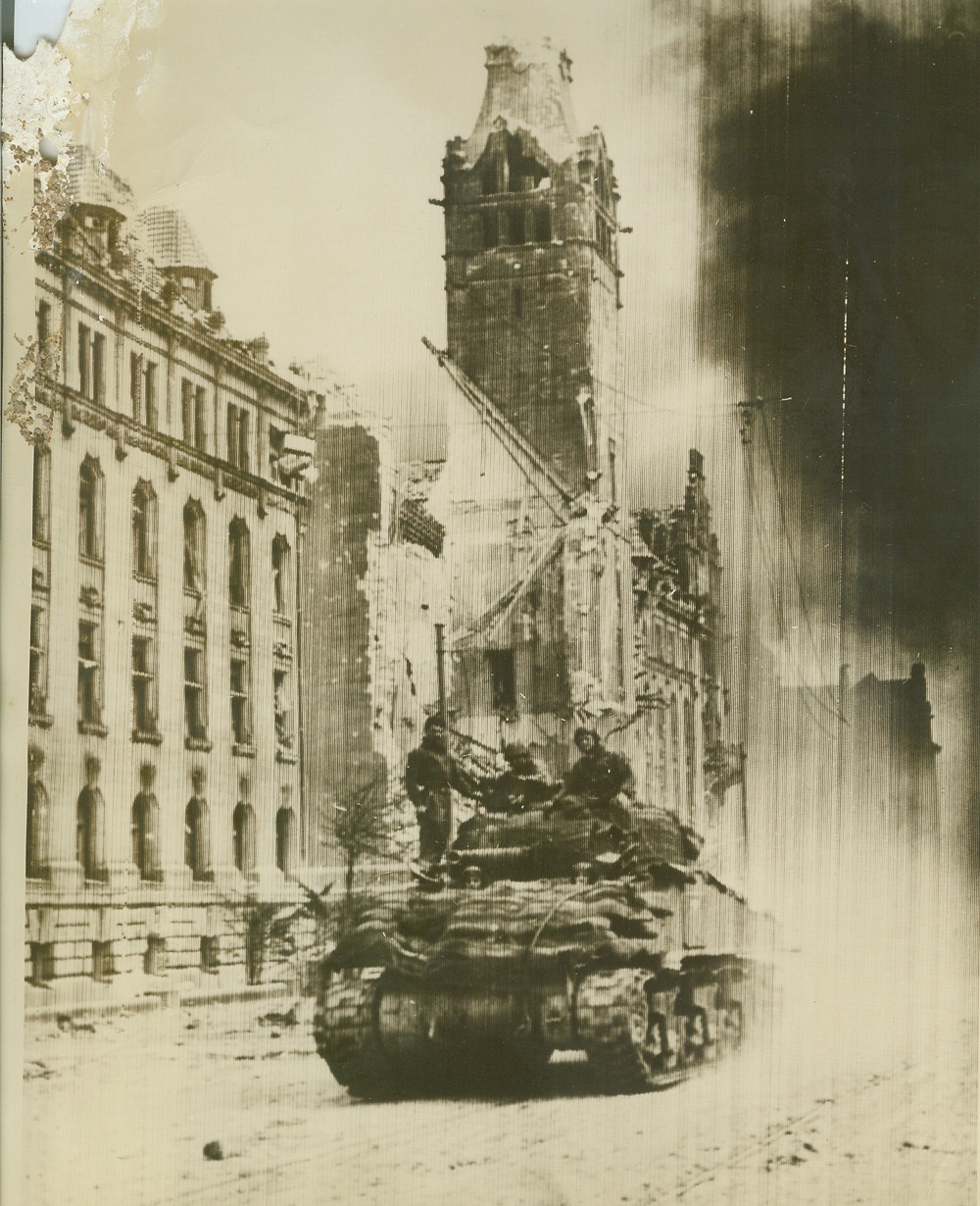
Yanks in Magdeburg, 4/18/1945. GERMANY – A tank of the 2nd Armored (Hell on Wheels) Division of the U.S. 9th Army, rumbles through a street in Magdeburg, against a backdrop of smoke and flames from still burning buildings. Ruins of the buildings show effects of the terrific battle of the city. Credit: (U.S. Signal Corps Radiophoto from ACME);
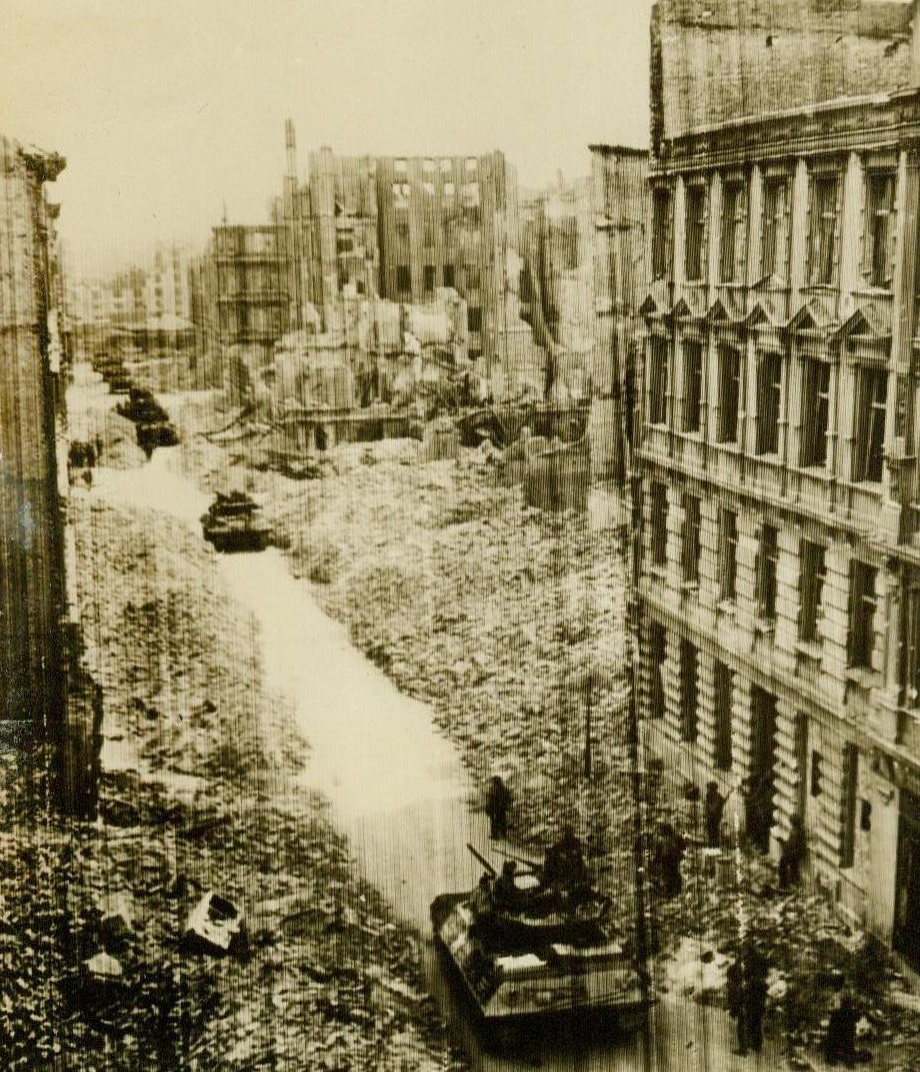
Yanks Enter Magdeburg, 4/18/1945. Germany – This photo, flashed to New York by radio tonight, shows tank destroyers and men of the 30th Infantry Division, U.S. 9th Army, moving up a rubble-strewn street in Magdeburg, as the Yanks captured the city. The buildings show the effect of the terrific battle fought there. 4/18/45 (ACME);
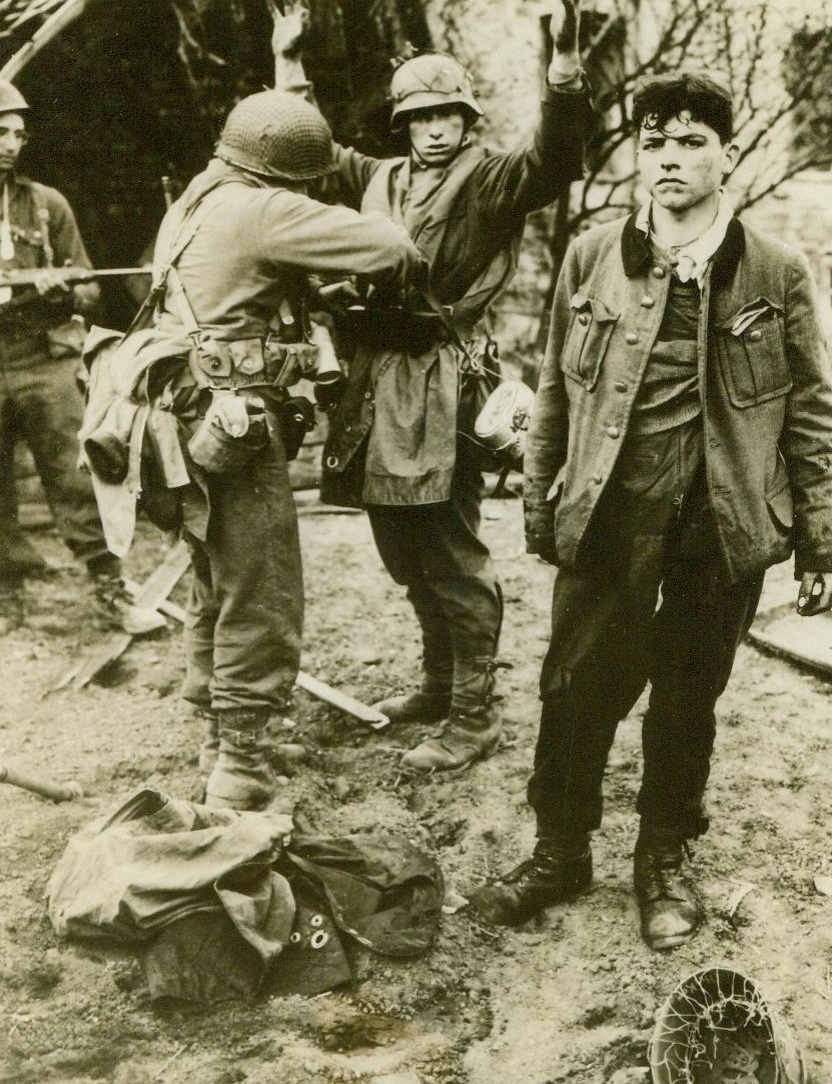
"Frisking" The Sniper, 4/2/1945. German sniper after his capture by forces of Gen. Patton’s Third Army. In the exchange of rifle fire before his capture, the prisoner was wounded;
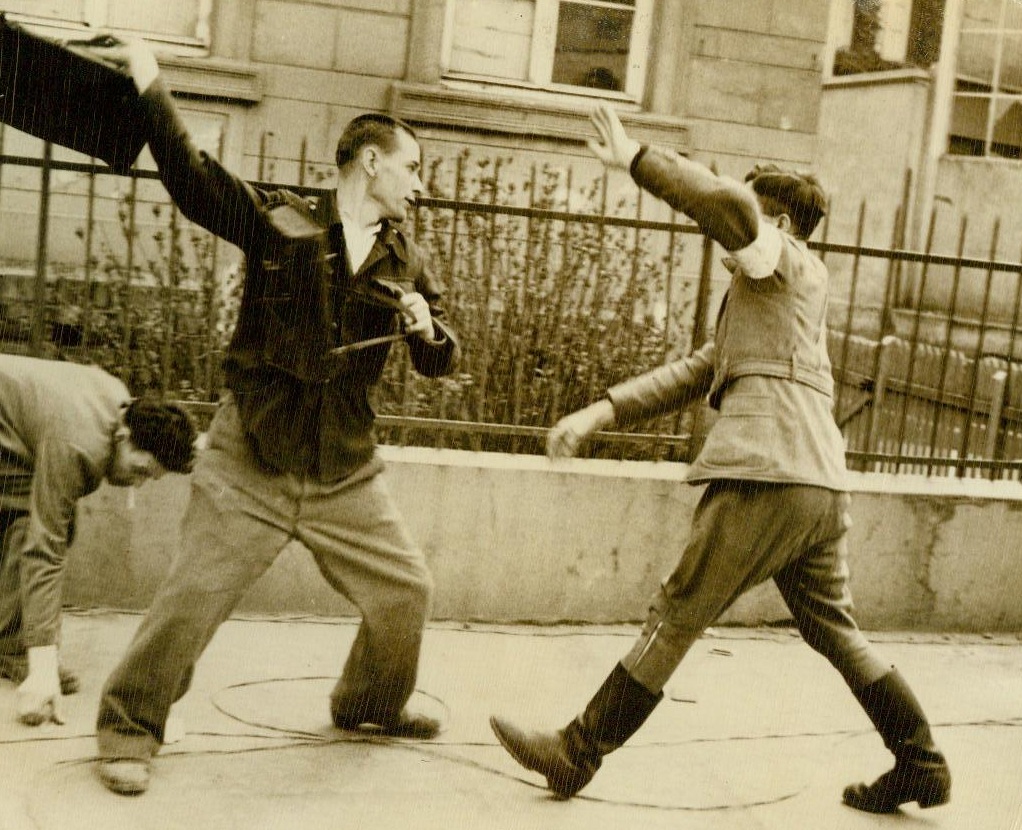
No Title. 4/3/1945. Bonn Germany – Liberated by the Allies and on their way to a “displaced persons center” in Bonn, former Russian slave laborers ran into a German civilian policeman – One of their erstwhile tormentors. It was a Russian victory all the way, as the freed man staged a lightning attack in the street. The battle ended with the enemy in full flight. Unleashing his pent fury and hatred, the Russian goes to work on the German policeman, who raises his arm to ward off the blows.;
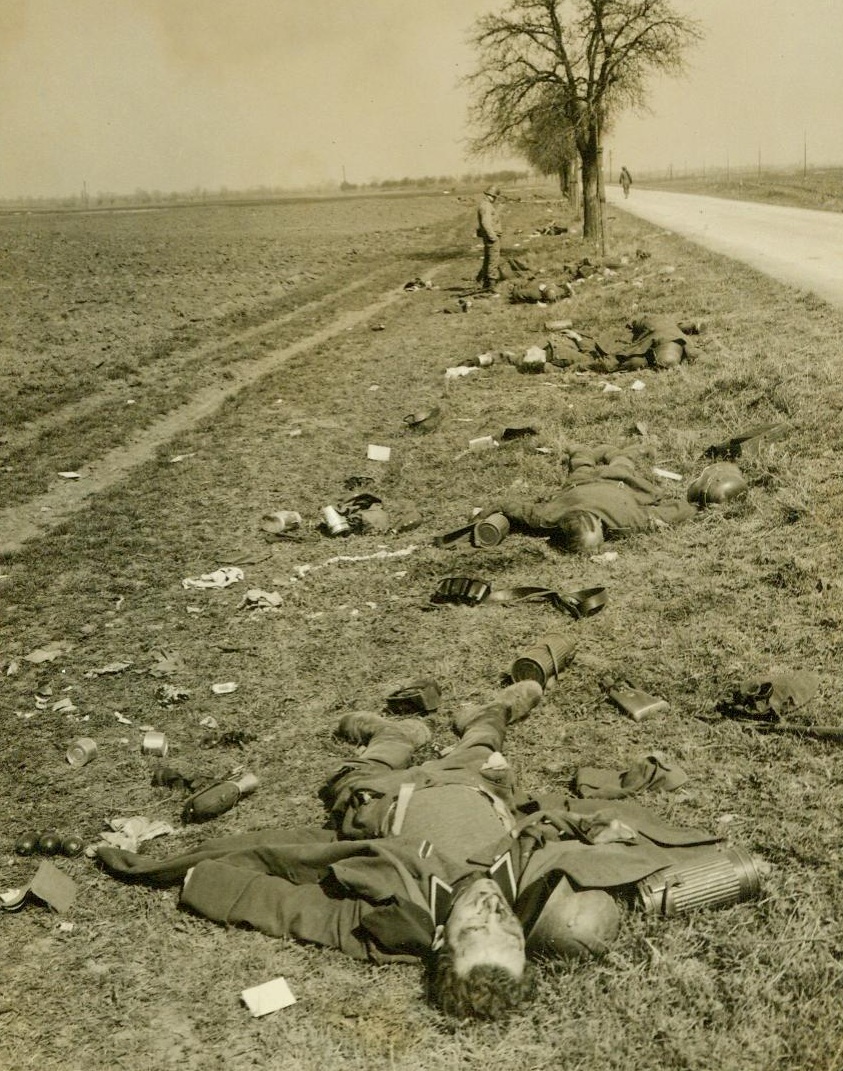
Dead Soldiers, 4/2/1945. Trebur, Germany – German soldiers, killed during the first daylight fighting in the U.S. Third Army Bridgehead on the east side of The Rhine, line the road to Trebur. Their equipment, including food rations and gas masks, are scattered over the ground. 4/2/45 (ACME);
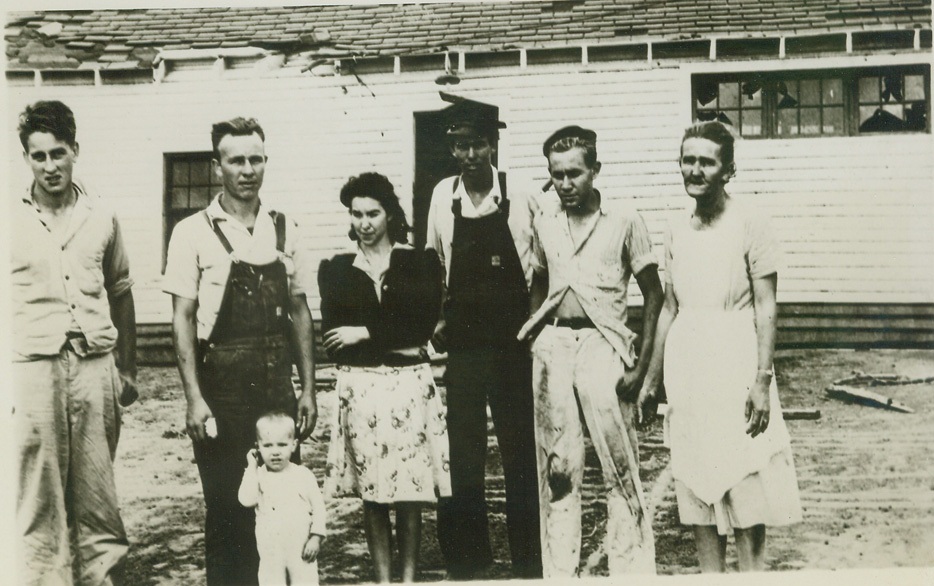
NARROW ESCAPE FROM DEATH, 5/12/1945. ANDERSON, S.C. – Visibly shaken after a close encounter with death, these seven people are shown before the combination store and filling station which was uprooted by a tornado and carried a distance of 150 feet. Left to right: Calvin Cross; Harbin Nash, and son; Mrs. Harbin Nash; Jack Moore; Junior Nash, and Mrs. H. A. Nash. All miraculously escaped injury, but hundreds of canned food containers were burst by the terrific pressure inside the structure. Credit: ACME;

It’s Good to Be Clean, 5/3/1945. Germany – Former occupants at the German horror camp in Belsen, these women take their first bath for three years in a hot shower set up by the British who liberated the camp. Note emaciated condition of these ex-preisoners who were victims of the Nazi starvation diet. Credit (British Official Photo From ACME);
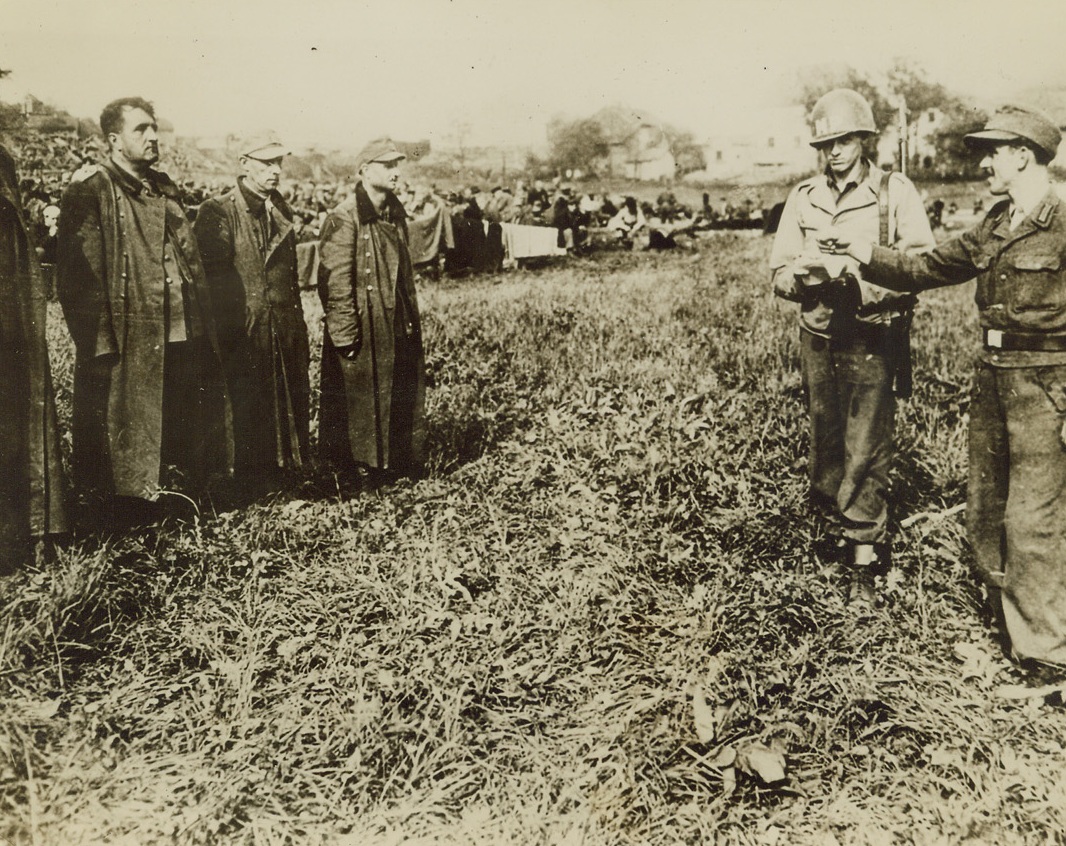
THE QUISLING IN THE CROWD, 5/22/1945. GERMANY—While an MP stands by, a German soldier captured by the U.S. Third Army near Passau, Germany, points the finger at an SS trooper, designating him as one of the men who shot American prisoners in cold blood at Malmedy, Belgium, during the battle of the bulge. There’s no arrogance seemingly left in these men, who once lorded it over their prisoners with whip and club.Credit: Acme;

This year, witches didn’t ride on May 1, 5/21/1945. BROCKEN, GERMANY – According to German legend, on Walpurgisnacht, May 1, witches ride though space on broomsticks and goats, then meet at the “Devil’s Pulpit” on Brocken to dance around the fire. Previously Hitler’s Youth gathered here on that night to hear their leaders, but this year neither of the devils appeared, and the only fire was lit by Sentry Pfc. Hershel Goddard, of Anderson, Ind., as protection from the howling wind atop Brocken. Credit (ACME) (WP);
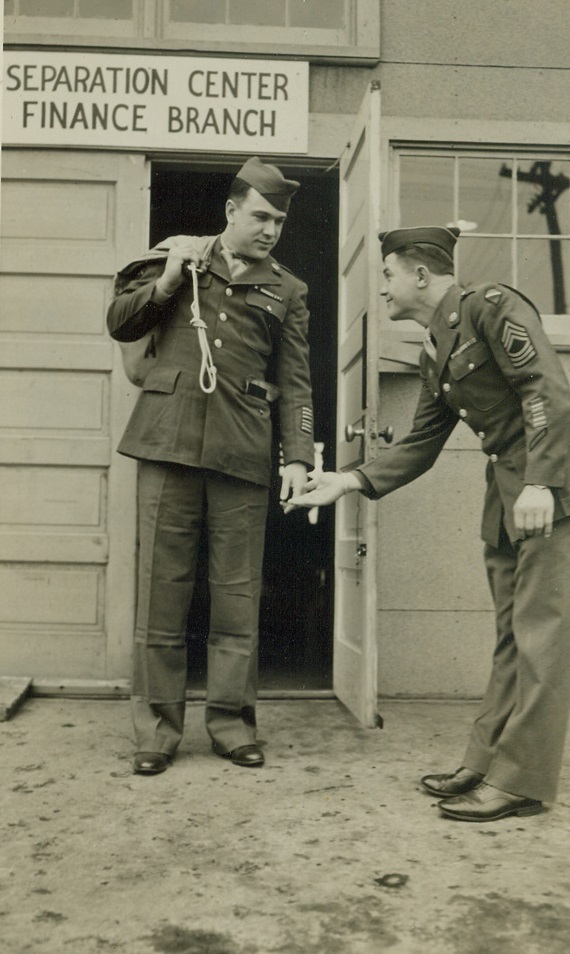
Farewell to Arms, 5/12/1945. Fort Sheridan, Ill. – Sgt. Rudolph Kolenic (right), of Muskegon, Michigan, one of 200 veterans demobilized today (May 12) at Fort Sheridan under the new point-discharge system, executes a courtly bow as Corp. Richard Lockhart, Ironwood, Michigan, credited with a score of 126 points—highest at Fort Sheridan—leaves for home, once again a civilian. Credit: ACME;
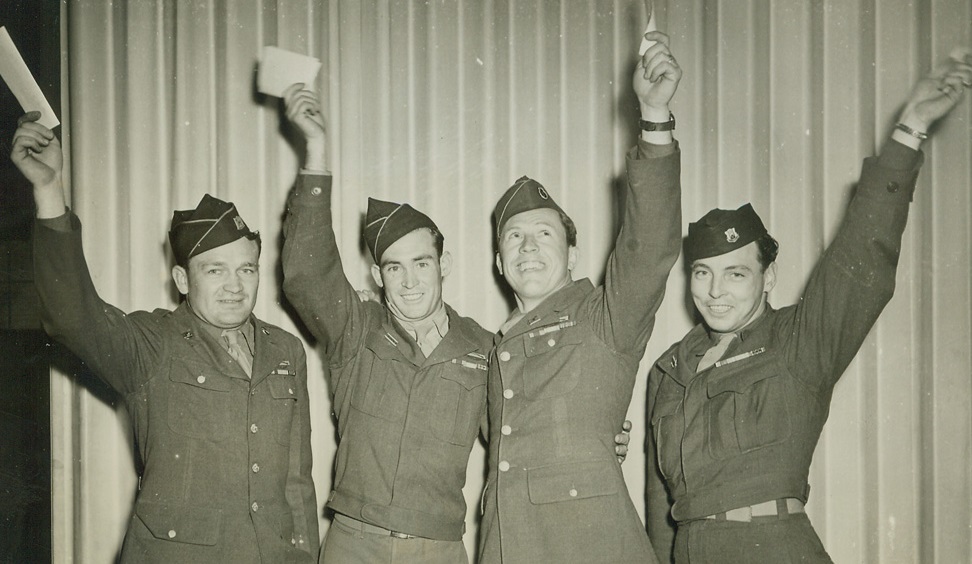
CIVVIES, HERE WE COME!, 5/12/1945. JEFFERSON BARRACKS, MO.—Flourishing their score cards, visual testimony of their 85 points or better, score that entitles them to honorable discharge from the service under the new point-discharge system, these vets are among the first to be processed at Jefferson Barracks. Left to Right: T/Sgt. Henry Bast, Cedar Falls, Ia.; T/5 William Archer, Mystic, Ia.; T/Sgt. Arthur Isenberg, Pleasantville, Ia.; S/Sgt. John Fitzgerald, Ames, Ia. Credit Line (ACME);
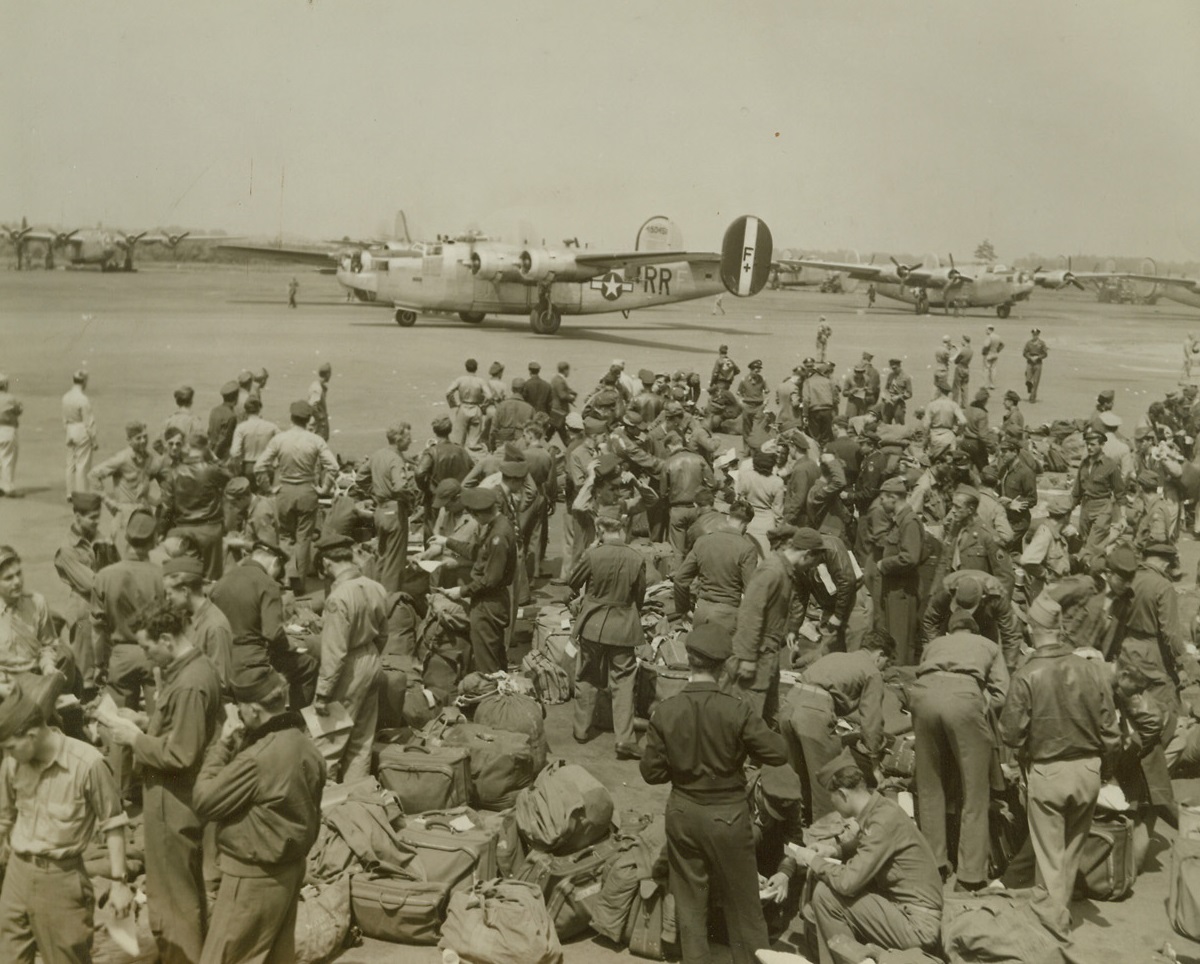
Bombers Fly Veterans Home from England, 5/22/1945. Connecticut -- The arrival of 50 battle bombers at airports between Springfield and Hartford today marked the first flight of a mass aerial ferry service from England to America, which is expected to return home more than 40,000 U.S. 8th Air Force personnel within the next 60 days. About 1,000 men were in the first contingent. The returnees will be given 45 days leave for “temporary duty, rest and recreation.” Here, at Bradley Field, some of the B-24 Liberators of the flight land. Men in the foreground have already landed in other ships. Credit: ACME;
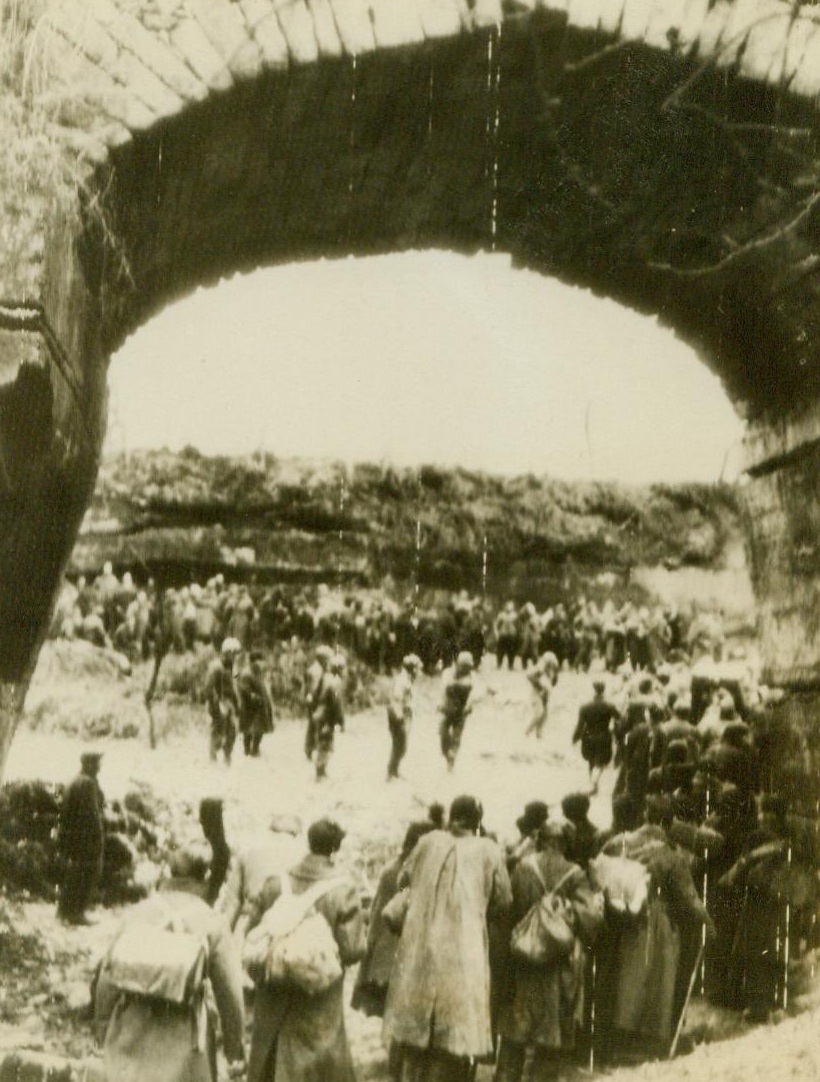
Mass Escape From Nazis, 5/6/1945. France – Some of the 1,200 Allied war prisoners, sick and wounded, who escaped from the German “Hell Camp” at Stiringwendel, yesterday (March 5th), after overpowering a skeleton detail of Nazi guards. Without weapons, they made their way to the lines of the 274th Regiment (U.S. 7th Army), which is under the command of Col. Samuel (Shooting Sam) Conly, of Van Wirt, Ohio. As the men escaped they were under heavy machine gun and sniper fire. Here (above), they wait for transportation to the rear. 5/6/45 (Army Radiophoto From ACME);

Surprise Attack Nets Six Jap Ships, 6/12/1945. Kurile Is. – Its stern blown away by a direct bomb hit from a Mitchell Bomber, this 2,500-ton Japanese cargo ship is dead in the water awaiting the attack from a second approaching Mitchell. The medium cargo was one of six enemy cargo and escort craft sunk or damaged by Aleutian-based Mitchells and Liberators in a surprise raid on a convoy at the Kataoka Naval Base, off Shimshu Is., in the Kuriles. Credit: Official U.S. AAF Photo from ACME;
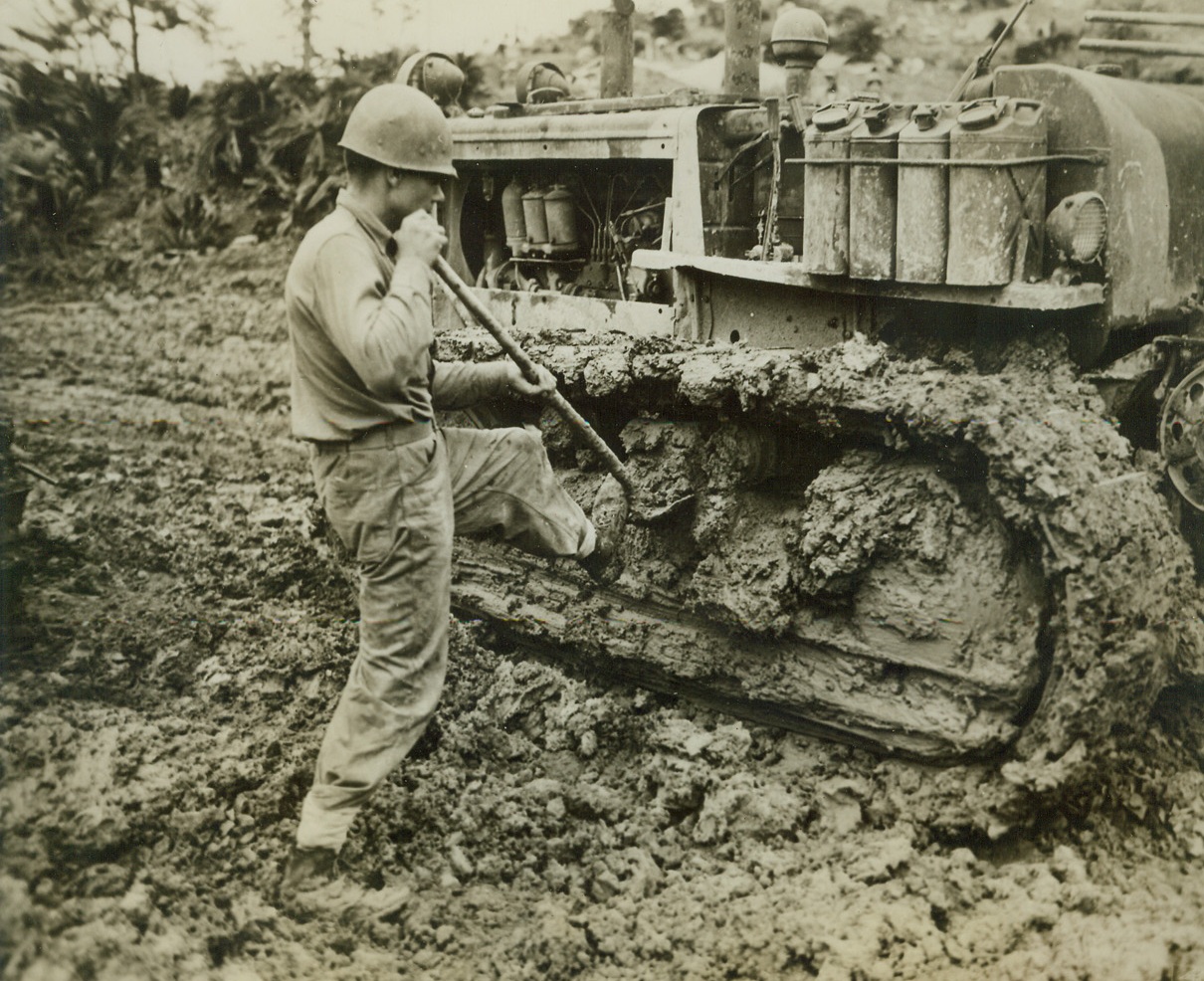
Digging Out On Okinawa, 6/11/1945. Okinawa -- At regular intervals, Marine ... Gilbert E. Bailey of Huntington W.V.,... to climb down and scrape shovelsful of... Okinawa mud from the tracks of his... The muck slows Yank progress on the ... down to a snail's pace. 6/11/45 Credit Line Marine Corps Photo From ACME;
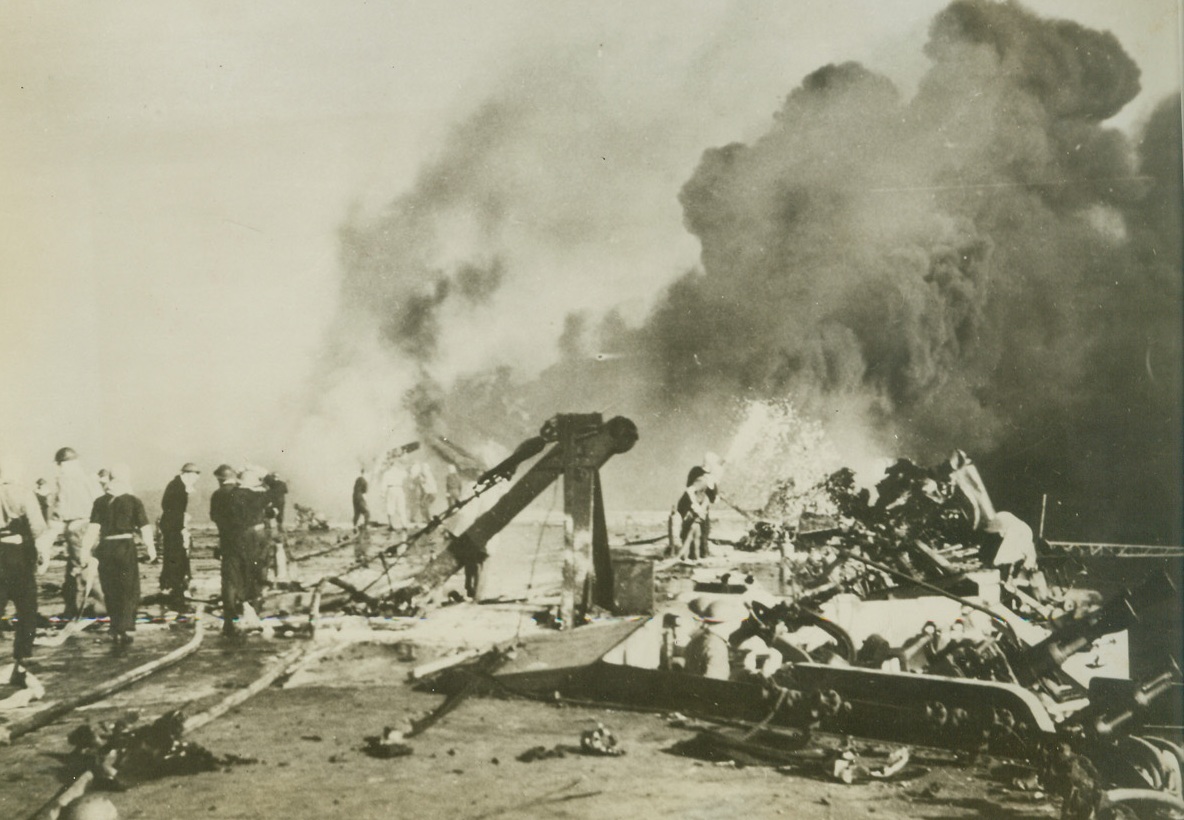
Suicide in Vain - #2, 6/22/1945. Off Sakishima Islands – Using one of its last resorts to stop the advance of the British and Americans, Japan sent pilots out on suicide missions during the recent Okinawa campaign. This British Pacific fleet carrier was the victim of a crash-diving Jap suicide plane during recent operations off the Sakishima islands, a few hundred miles from the Japanese mainland, when the British were striking in support of U.S. operations on Okinawa. Seven suicide planes were reported to have crashed into British ships, including two carriers, neither of which was put out of action for more than a couple of hours. Photo shows: Thanks to the efficiency of the firefighting crews, the main part of the blaze has been extinguished, and they spray their equipment on the smoldering wreckage on the flight deck of the carrier. Operations were delayed only two hours. Credit (British official photo from ACME);
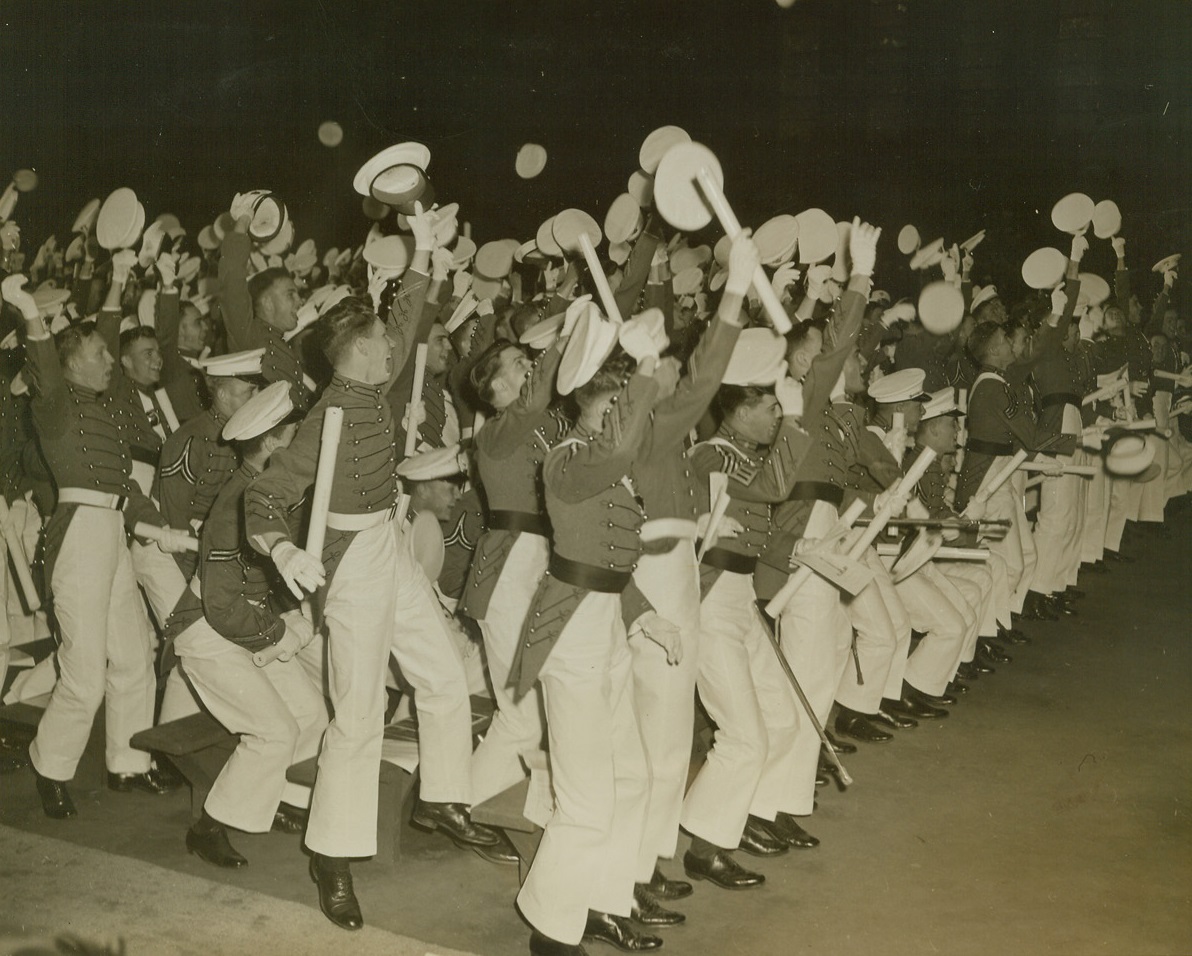
853 Hats in the Air, 6/5/1945. West Point, New York -- In keeping with tradition, 853 cadets toss their hats into the air as the last man in their class receives his diploma during 1945 commencement exercises at the U.S. military academy on June 5. It was the largest class ever to graduate from West Point. Credit: ACME;
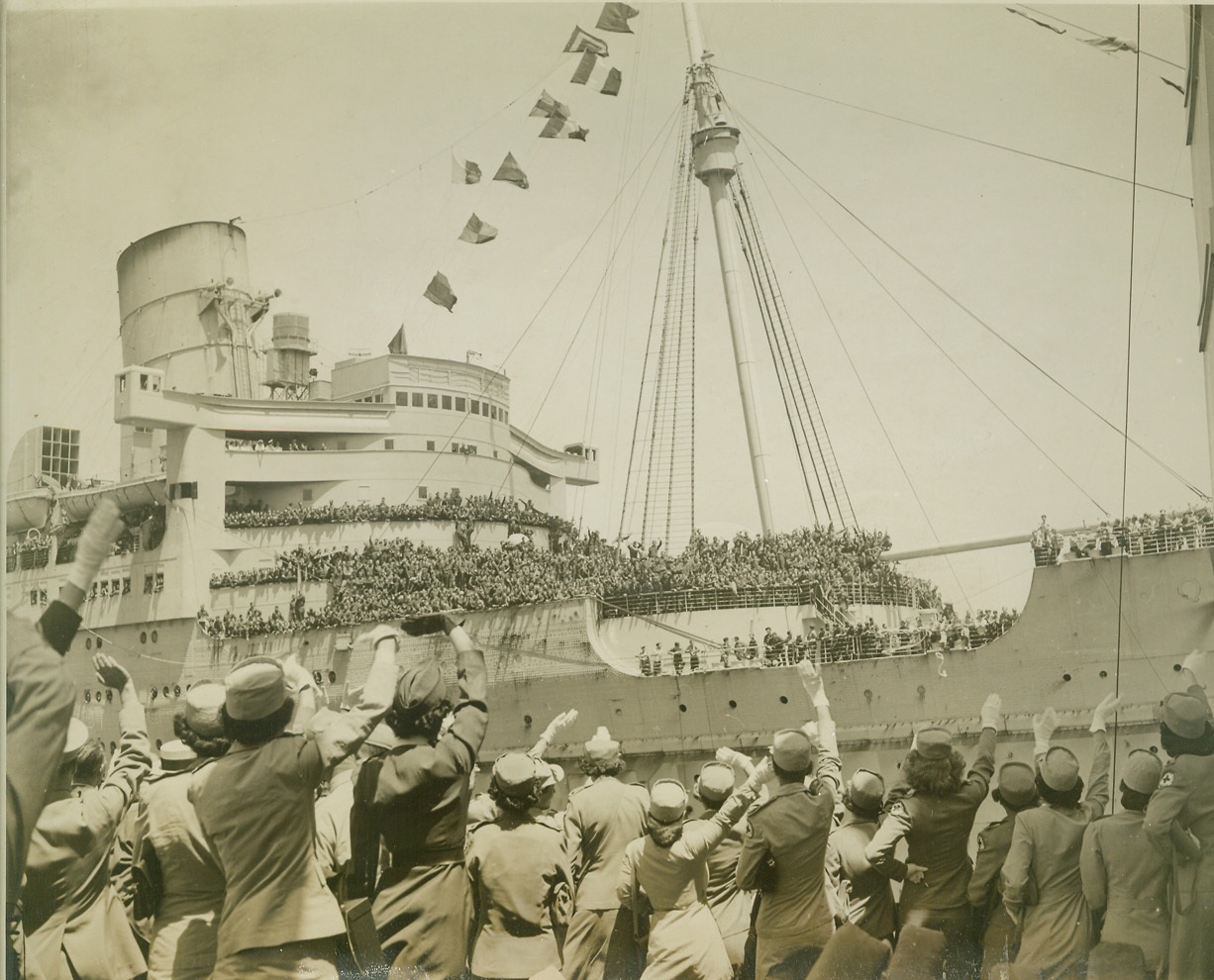
WELCOME HOME, BOYS!, 7/11/1945. NEW YORK – Returning soldiers jamming the decks of the giant transport Queen Mary get enthusiastic welcomes from Red Cross workers filling the pier. The Mary, one of eight transports which docked in New York today, carried 15,642 troops, including 7,000 members of the Canadian First Army, who boarded special trains for Canada immediately after docking. Credit: ACME;
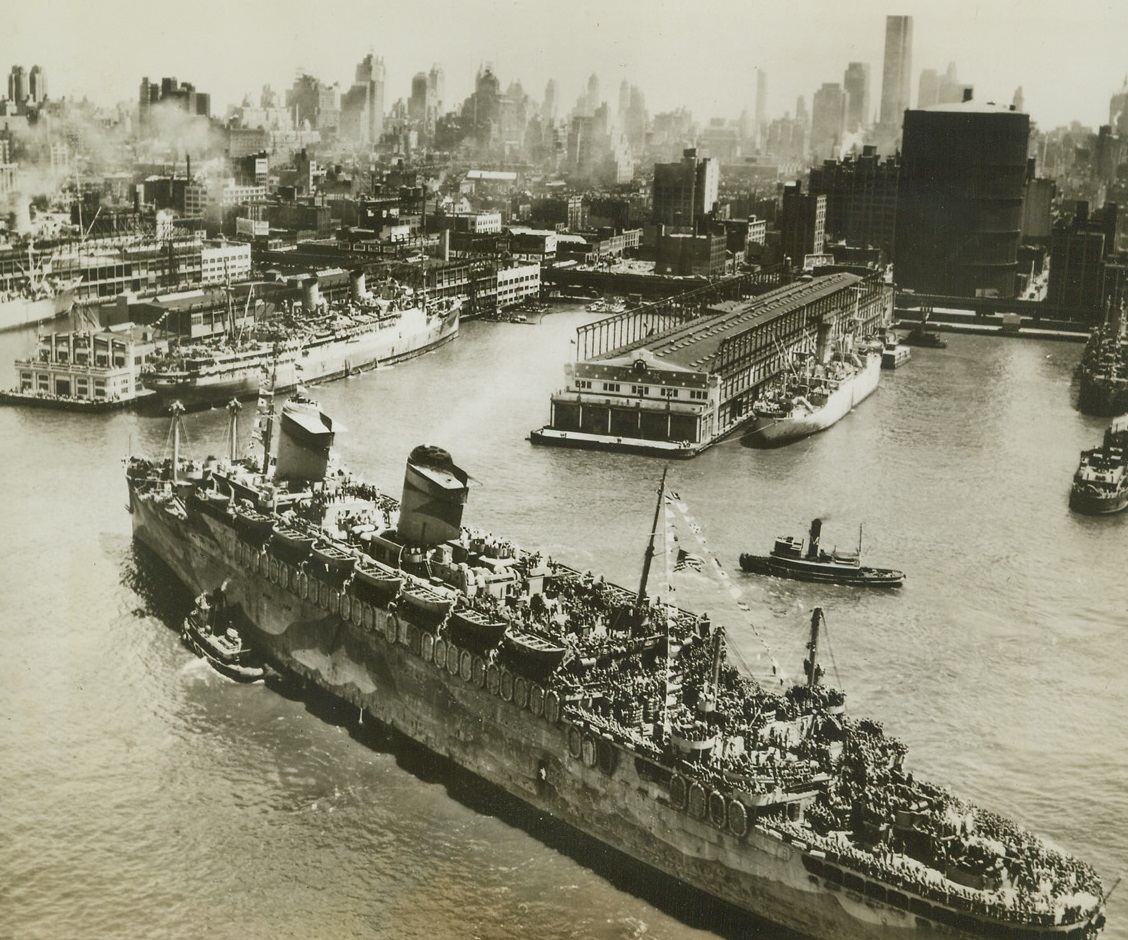
7,607 Dreams Come True, 7/11/1945. New York – Its signal flags fluttering in the breeze, and its decks lines with 7,607 eager Yanks of the 87th Division, the Navy transport West Point, largest Navy transport afloat, noses into her slip at Pier 88, North River, today (July 11). New York skyline rises in the background, a welcome sight for these battle-weary soldiers. Also aboard were a group of Japanese diplomats from the Embassy in Berlin, bound for internment. Credit: Official U.S. Navy photo from ACME;
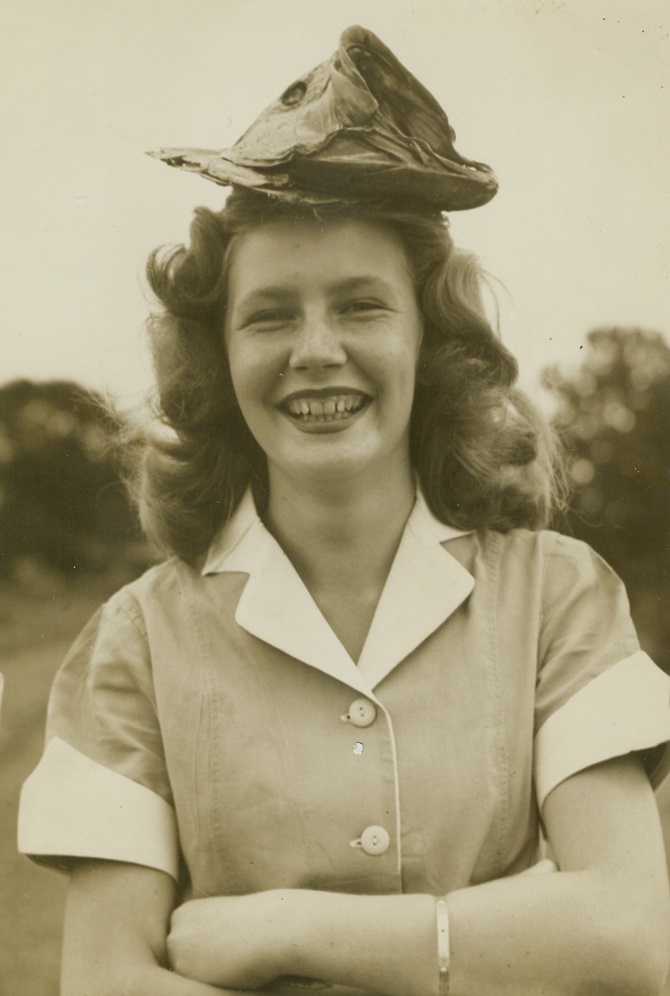
Looks Fishy, 7/13/1945. Lake James, N.C.—If this poor fish had known enough to keep his mouth shut, he would never have wound up as a hat. But he didn’t, so consequently Helen Steele, Asheville, N.C., has a fragrant new hat. The bass was caught in Lake James, N.C., by a fisherman friend of Helen’s. Credit: ACME.;
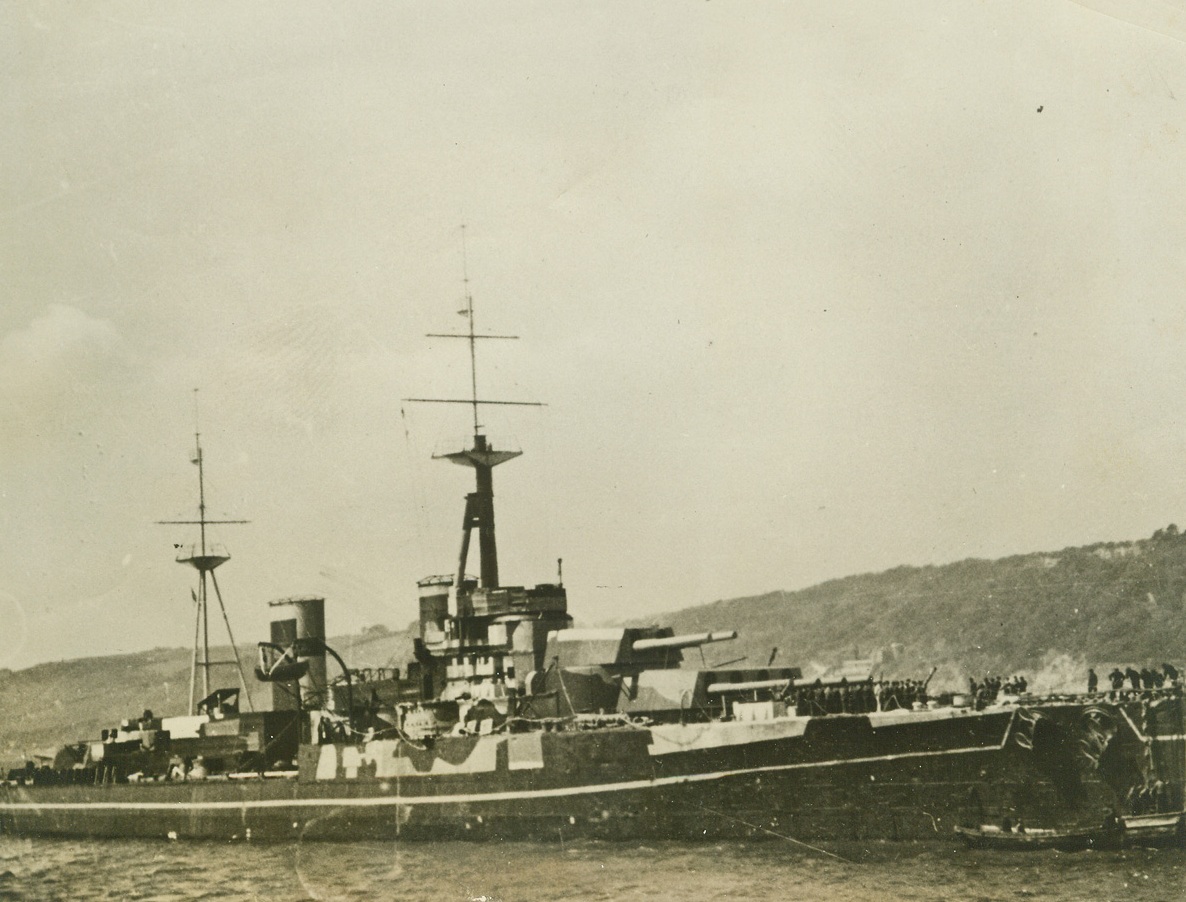
DUMMY FLEET FOOLED NAZIS, 8/4/1945. For nearly two years of war the British Navy used a phantom fleet of wooden warships fitted with dummy guns to fool enemy recon aircraft and bombers, it is now revealed. The dummy fleet consisted of merchant ships with elaborate superstructures of plywood and canvas, painted to transform them into replicas of battleships and an aircraft carrier. They were used as bait for U-boats, and as aerial decoys to draw air attack from base ships at Scapa Flow and in the Firth of Forth. A real battleship, the 33-year-old HMS Centurian, carried this make-believe into foreign waters with success. As the camouflaged version of 35,000-ton HMS Anson, the Centurian sailed over 20,000 miles during which she was repeatedly attacked. Unsung heroes of the British Navy are the courageous crew members of this dummy fleet who faced the enemy almost unarmed. NEW YORK BUREAU This is HMS Centurian decked out in fitting camouflage which makes her a creditable imitation of the new 35,000-ton HMS Anson. In June, 1942, she sailed in a Malta convoy that was intercepted by the Italian Fleet. She was repeatedly attacked by bombers, hit once and damaged by several near misses. Her greatest danger was that her wooden guns might catch fire. After sailing as far as the Indian Ocean, the Centurian was finally sunk as a block ship off the Normandy Coast on D-Day to form a breakwater for landing craft.;
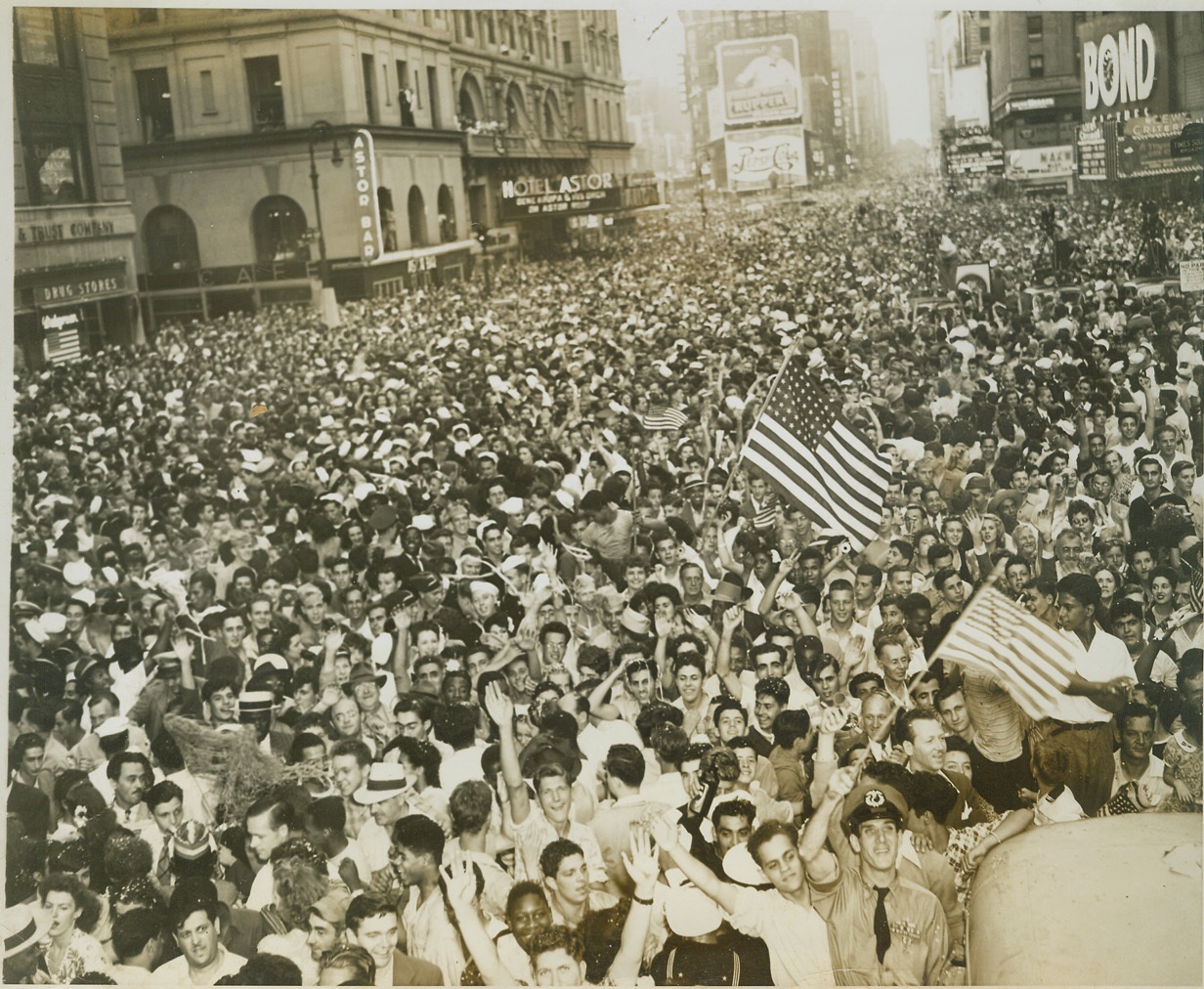
Once in a Lifetime!, 8/14/1945. NEW YORK, N.Y. -- When hours of waiting were ended by the announcement that the war with Japan was over, crowds jammed Times Square from side to side and from 42nd Street to 50th Street. Here, the photographer pictures the largest crowd that ever jammed the famous square. Photo was taken looking North from 42nd Street. Credit: (ACME);
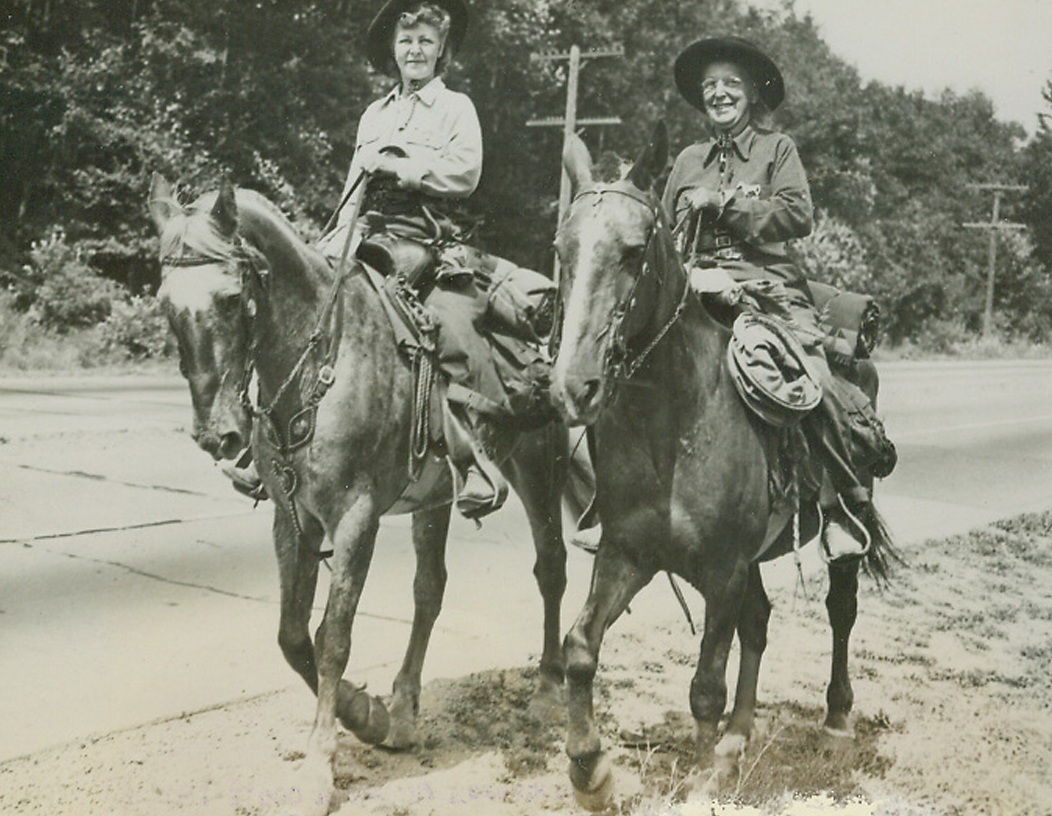
Travel 1,000 Miles by Horseback, 8/17/1945. Seattle, Wash.—Angered by rationing board’s refusal to grant extra gas for trip to northwest, Mrs. Frances N. Davis (left) and Mrs. Nellie McDonald arrive in Seattle, Wash., completing 1,000 mile horseback ride they started June 7 from Santa Cruz, Calif. They intend to return to California on horseback despite lifting of gasoline rationing.;
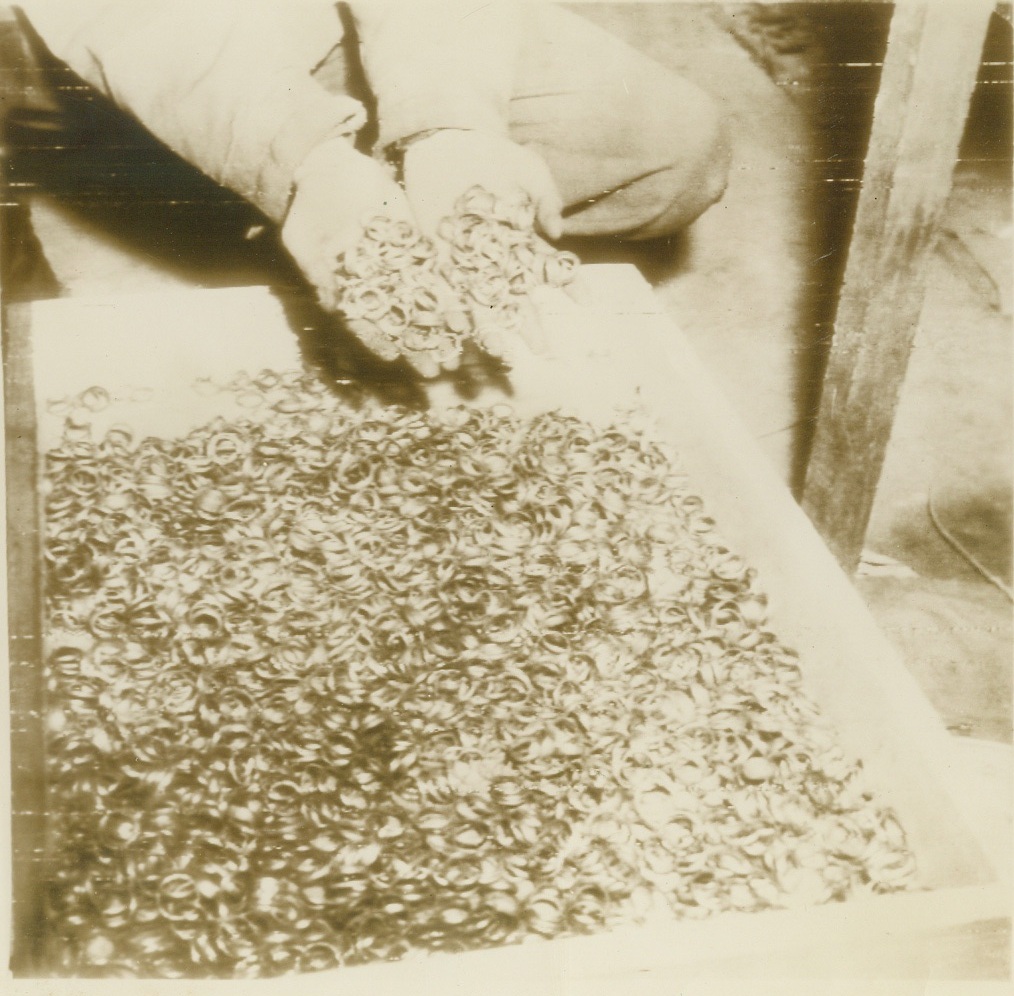
Buchenwald Wedding Rings, 8/5/1945. These thousands of wedding rings were found by U.S. 1st Army troops in a cave adjoining the Buchenwald concentration camp near Weimar, Germany. Signal Corps caption says they had been removed by Germans from their victims in order to salvage the gold. (AP Wirephoto from Signal Corps Radiophoto);
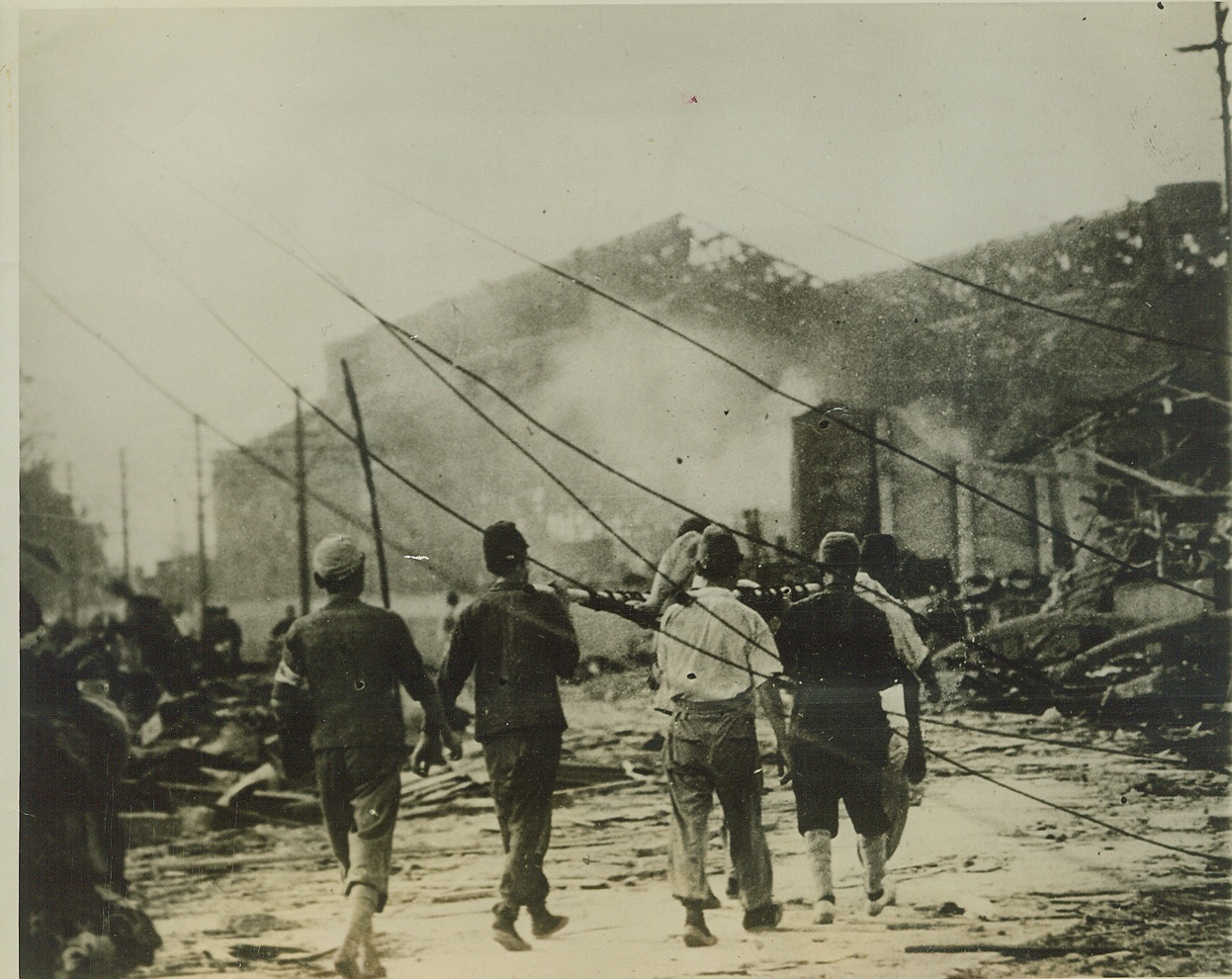
Down in Nagasaki - When Atomic Bomb Struck, 9/10/1945. NAGASAKI, JAPAN -- Rescue workers carry the body of an atomic bomb victim through the still-smoking streets of ruined Nagasaki. Crushed and crumbling ruins can be seen on every side of the doomed city, while fallen telephone wires string across the front of photo. This exclusive ACME photo was obtained by Andrew Lopez, ACME Photographer for the War Picture Pool, through civilian sources. Credit: (ACME);





 Trash & Recycling
Trash & Recycling
 Online Payments
Online Payments
 City Documents
City Documents
 Parks
Parks
 Traffic Court
Traffic Court
 CITY PARKS
CITY PARKS
 Outdoor Recreation
Outdoor Recreation
 Volunteer
Volunteer
 Home
Home TRANSLATE
TRANSLATE
